STUDENT VOICE OF MILPITAS HIGH SCHOOL
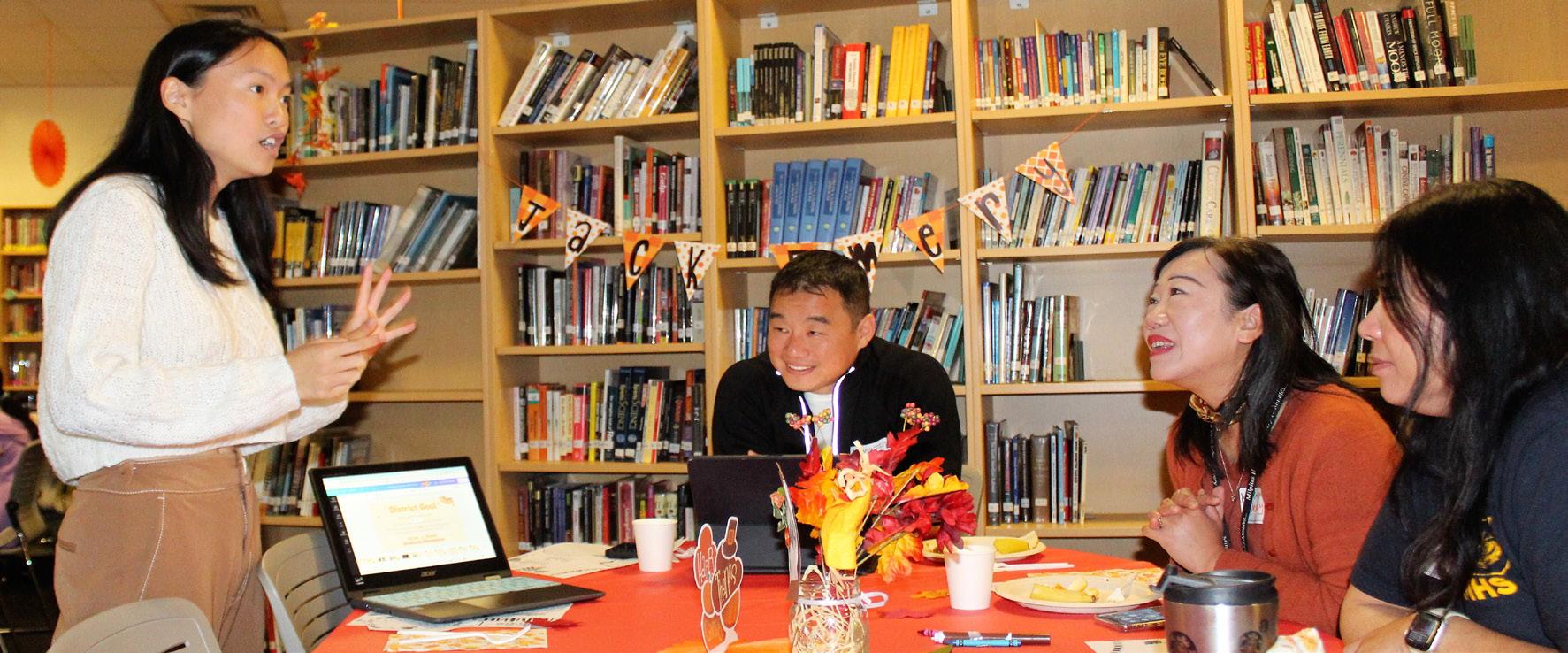
Kononenko family houses Ukrainian refugees, sends military support
By Satvika Iyer
Sophomore Alena Kononenko can still remember the moment she knew her life would never be the same, she said. She felt awful, sitting in a silent car in a mall parking lot with her mom and sister, freshman Uliana Kononenko, she said.
The Kononenko sisters are half-Russian and half-Ukrainian immigrants, Alena Koneneko said. When Russian President Vladimir Putin declared war on Ukraine in February earlier this year, all Alena could think of was her family in both Russia and Ukraine, she said.
In 2014, their mother, Elena Kononenko, was arrested for protesting in Russia and given a choice to work for the government or disappear, Uliana Kononenko said. The family instantly packed their bags and left for America, she said.
“My dad’s Ukrainian, and I just remember looking to him for a sign of emotion, almost if it was okay to cry,” Uliana Kononenko said. “What I saw was how calculated he was, already booking flights and doing whatever he could to keep his family safe.”
Growing up in Russia, the sisters grew up with a keen awareness of Russian animosity towards Ukraine. Uliana Kononenko is proud to be a Russian immigrant, and until 10 months ago, she had never identified as half Ukrainian, she said.
“I feel like I’ve earned that identity now,” Uliana Kononenko said. “I feel terrible when I get caught up in my life twelve hours away and stop thinking about the war. The constant worry I have counts for something.”
The day after the invasion began was the most stressful, Alena
CTE, language courses will fulfill arts requirement
By David Rendon
The MUSD School Board unanimously passed a policy on Nov. 15 to make one Career Technical Education (CTE) or world language course an alternative to visual or performing arts for graduation requirements.
On Sep. 27, the California stsate legislature signed assembly bill (AB) 185, which restored the authorization of CTE to serve as an alternative for graduation requirements, Director of Secondary Education Maurissa Koide said.
The MHS Silicon Valley Career Technical Education currently serves about 40 students, counselor Beth Harke said. The impact will be greater as MHS offers other CTE courses like its academies, Harke said.
This policy will not affect current students in the middle of their education. Harke said. The first class this will impact will be the class of 2027, Harke added.
Kononenko said. The constant barrage of photos, videos, and articles reminded her of her inability to help her family in Ukraine, she said.
“For a day and a half, we couldn’t get a hold of them, and I didn’t know if I just lost half of my family right then and there,” Alena Kononenko said.
Thankfully, her family in Kyiv fled to the Polish border as soon as the news of the invasion broke, but hit a roadblock when trying to bring the Kononenkos’ grandmother along, Alena Kononenko said. Her grandmother stayed in Ukraine for two weeks before she left for the Polish border, she said.
“My grandma was so overwhelmed that she couldn’t even put on her shoes,” Alena Kononenko said. “She couldn’t imagine leaving the country she grew up in.”
At the Polish border, Kononenko’s grandmother was met with the shocking scenes of a cratered Poland, where she faced bomb threats that required her to lay on a cold bathroom floor for 72 hours on end, Alena Kononenko said.
“A building near my grandmother’s home was just a giant hole after being bombed, ceiling and wires sticking out,” Alena Kononenko said. “Anyone laying down in their bathrooms was dead.”
The Kononenkos’ aunt, cousins,
Gary returns as interim principal, hopes to resolve issues
By Satvika Iyer
Former MHS principal Charles “Chuck” Gary Jr. returned to serve as the interim principal from Nov. 1 through the remainder of the 2022-23 school year, according to a ParentSquare message from the office of the Superintendent Cheryl Jordan. Gary, who was principal from 19882008, will lead and support administration and staff and work with the district as well, according to Jordan’s message.
According to Gary, the school’s budget is an issue of concern.
“The budget is overspent,” Gary said. “The district is going to address the issues of the budget and
the over-expenditure. My understanding was that the previous principal was pretty authoritarian around the budget, and that there was no involvement of any of the staff regarding funding.”
Staff leadership meetings on the budget were a precedent during his last term that he reinstated his first week back, Gary said.
“My intent is to have a budget process where all the money is on the table,” Gary said. “That means that nobody should be coming up to the administration’s office next year and asking for money. The leadership team and department leads should have already discussed it.”
Gary is also working with ad-
ministration and security on student discipline and safety issues, he said. Campus security and discipline are always the most apparent issues, he added.
“We need a sense of community on campus, and the only way that administration can be a part of that community is to be visible in classrooms and on campus,” Gary said.
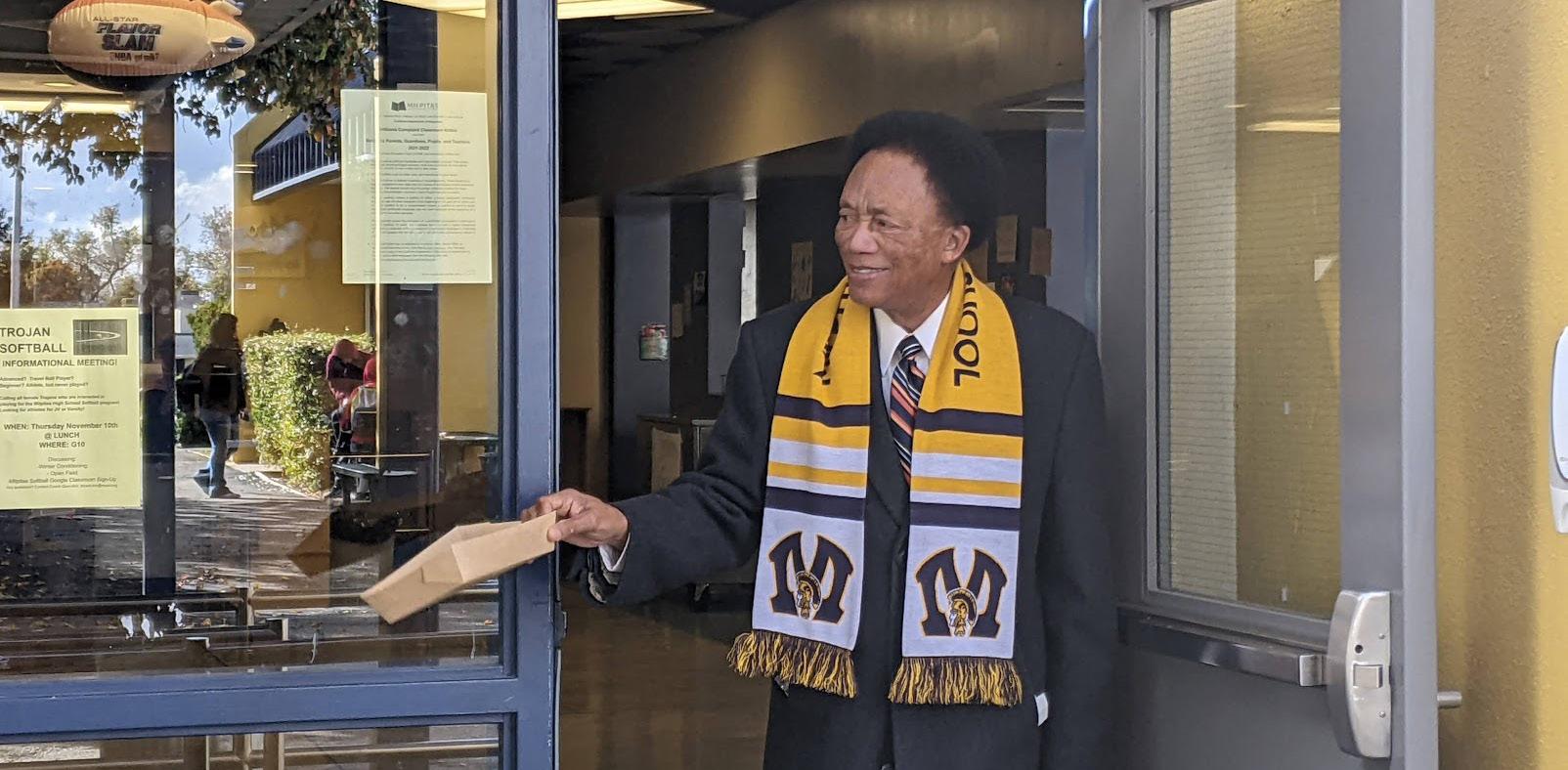
Relying on staff for lunch duty is inefficient, and issues like vaping in the bathrooms and students leaving campus during lunch require direct action, Gary said.
“There needs to be either security or admin at those places that

Special education substitute wage rate increases
Jack Emery Drive comes back, collects fewer donations
By Anannya Bhuskat
The annual Jack Emery Drive is back this year but has seen a decline in the amount of cans and goods donated by students, according to Associated Student Body (ASB) president and MUSD Jack Emery Drive coordinator, senior Victoria Ly. ASB has continued to encourage students to donate change, cans of food and other non-perishable goods in order to provide food and money to the local Milpitas Food Pantry, and has worked on fundraising with local restaurants and businesses, she added.
Last year, MHS collected more than 48,000 cans, exceeding its goal by over 20,000 cans, according to ASB vice president and MHS Jack Emery Drive lead, se-
nior Gavin Heraldo. As of Dec. 8, 2022, the school has raised a total of $16,315.68, mostly from monetary donations, out of the 22,000 major can goal and 20,000 minor can goal where two cans equal one dollar, he added. This year, the drive has not been as supported by important benefactors, such as the Positive Alternative Recreation Teambuilding Impact (PARTI) program, which donated $9000, equivalent to 18,000 cans, last year, but is only willing to donate conditionally this year, Heraldo said. The program said they will donate $2500 if ASB can convince ten people to participate in a nonviolence fashion show and model outfits sponsored by fashion companies, he added.
“ASB is trying to pinpoint a reason why donations are signifi-
cantly less this year, but it’s hard to find one because last year was such a special case coming back,” senior class secretary and Collections Committee lead Annalise Ho said. “We are looking at ASB as an example as to what we did wrong and what we did right. It could be that we simply didn’t publicize enough, or it could be because of inflation that people do not have the means of donating themselves,” Ho said.
ASB is offering various prizes such as ‘pieing’ administration and teachers, celebrating with donuts and pizzas, and individual gifts from teachers to incentivize students to donate, junior class president and Jack Emery events

The daily wage rate of substitute teachers in special education classrooms will increase for the remainder of the 2022-2023 school year, Superintendent Cheryl Jordan announced at the MUSD Board of Education meeting on Nov. 15. The policy has been implemented in an effort to reduce substitute teacher shortages for special education classrooms, she said.
The current daily rate is $225.00 and $275.00 for day-today and long-term substitutes, respectively, and will be raised to $275.00 and $325.00, respectively, according to Jordan. The wage raise will be applicable to both day-to-day and long-term substitutes across all schools in the district, she said. Substitutes will only receive the increase when they teach special education, including resource, special-day, and community-based instruction (CBI) classes, she added.
“Substitutes are paid $45 if we cover regular classes during our prep period, so if you compare this to the extra $50 from all the additional monitoring and crowd control involved when supervising special education classes,
U
THE
NI N
MHSTHEUNION.COM FOR THE LATEST UPDATES DECEMBER 2022 VOLUME XXXV ISSUE III REOPEN LIBRARY EDITORIAL (3) ‘PUFFS’ THEATRE REVIEW (12) CROSS COUNTRY MAKES STATES (14) HOLIDAY SEASON SPREAD (8-9) STUDENTS FEEL LEFT BEHIND BY BUSES (7)
SEE PAGE 16 SEE PAGE 16
Satvika Iyer | THE UNION
Victoria Ly introduces the Jack Emery Drive to MUSD administrators at the kick-off brunch event on Nov. 7.
Courtesy of Victoria Ly
SEE PAGE 16
By Stephen Huang
SEE PAGE 16
Interim principal Charles Gary passes out lunch trays to students on Dec. 8, 2022 in front of the cafeteria.
As students gear up for finals, many find themselves drowned with work and projects given by their teachers in order to prepare them for exams. Students, often drained this time of year due to excessive assignments, tend to spend their time cramming in study sessions, and teachers become burnt out as they attempt to finalize last-minute lessons. The decision to give students and staff the entire week off for Thanksgiving break is beneficial because it gives students and staff additional time with their families and extra days to destress.
In past years, MUSD only allocated three days for teachers and students to have off during Thanksgiving week. Although this allowed students to visit their families and take a short period of time away from deadlines, it did not allow them nearly enough time to rest. The extended break gives students the opportunity to participate in activities they usually would not usually have time for. Teachers will be better prepared to teach their students and do so with significantly more dedication and energy if they are well-rested themselves.
Not only does extending the break give students and staff the opportunity to spend more
time focusing on their well-being, but it allows them to spend more time with their loved ones.
According to “Advantages of School Holidays,” an article by Allison Academy, longer breaks allow students more time to take part in activities that are “most often practiced during holiday celebrations.” Extended holiday breaks give families more opportunities to reconnect with one another as they celebrate the season.
Additionally, as a result of the colder weather, there is an increased chance of contracting and spreading illnesses. An extended break gives students more time to recover from any possible illnesses. This will decrease the number of ill students going back to school after a break, preventing them from missing any class time as a result of being sick. This will prevent sickness from spreading around campus, and more students will be able to return to class healthy and prepared to put their best foot forward.
In allowing students and staff additional time off for Thanksgiving break, MUSD is allocating more time for those busy with school work to take care of themselves and spend the holidays with family by giving their schools two additional days.
CON
This year, students had a week off for Thanksgiving break rather than the usual three days. While the extension provides more time to spend with family and to relax, it also leads to a loss of learning, heading into finals week.
The extra two days take away from the time students will be able to spend in the classroom. This causes teachers to have fewer days to teach students new material and less time for students to review. With a whole week off, students will be on their own in terms of studying as compared to structured review and learning during a typical school day. This lack of structure will prove detrimental as many students need structured study time in order to retain information and apply it.
While some students may take the time to study over the break for their upcoming exams, a large portion of students will not. The week-long break will cause many students not to take advantage of the time and instead resort to cramming closer to final exams.
According to “Cramming: Why It’s Ineffective & Should Be Avoided” by stanford.edu, “... such behavior should be broken because it is ineffective and could even pose a hazard to one’s health. It goes without saying that cramming places too much stress onto the brain, pushing it beyond its limits.”
Due to the added stress from cramming, many students will
come back from the week-long break feeling stressed as they begin to cram for finals. Realizing the amount of time they have before finals week. With structured learning time in the classroom, students will not have to cram and can thus retain information for their final exams.
The extension of Thanksgiving break not only affects students but also teachers as they need to adjust their lesson plans to fit the new schedule. This adjustment causes some lessons to be cut out of the normal teaching plan, according to Social Studies teacher Casandra Parada.
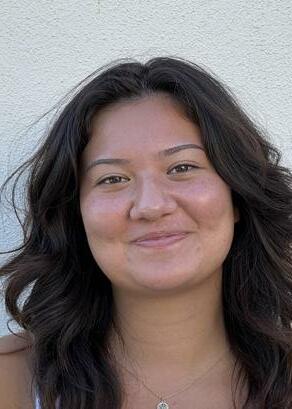
“I didn’t realize that it was going to be compressed until this week coming back, but I had to squeeze a lot more in because we lost those two days,” Parada said. “I had to cut a couple lessons while still trying to get through the curriculum.”
However, Parada also argues the need for having a break during the fall time to ease students’ stress as they head into finals.
“I think we needed a break at some point this year,” Parada said. “I know some districts give an October break, so that might be something that we could look into or benefit from versus Thanksgiving break.”
A week off school for Thanksgiving break may feel like a relief for students in the moment, but considering the repercussions it could have on a students’ academic performance during their finals week, the break should not be a full week.
OPINIONS
Gift out of love, steer away from obligatory
The holiday season is upon us, and with it, the seemingly unavoidable gift-giving season. For some, this time of year has been a long time coming as they plan ahead with gift baskets for loved ones, while others sport their art skills with handmade tokens of appreciation or timeless letters. While gift-giving tends to look different from person to person, I believe that people should continue to involve meaning in the act so that the spirit of the holidays persists and waste is avoided.
Coming up with ideas for presents does not come instantly; it often requires mulling over several options before settling on one. Where most people turn the corner prematurely, however, is by skipping the latter step entirely. With the holiday season compelling people to participate in festivities as much as possible, this sometimes can mean buying gifts simply to partake in the spirit of the holidays. Buying gifts out of obligation leads to mindless gift giving
— when money is splurged on items with little effort or meaning behind them. Not only does this practice counteract the entire point of gift-giving, it is clearly unsustainable for the environment.
For example, Stanford University, under their article “Holiday Waste Prevention,” found that Americans create 25% extra waste during the holiday season, and that waste amounts to 25 million tons. From the heaps of gift wrapping to bow ties, it is not difficult to imagine how much waste could be reduced if people simply steered clear of careless gifting. In a win-win situation, people can genuinely feel the emotional weight of their gifts while also taking a burden off of the environment.
ADRIAN PAMINTUAN
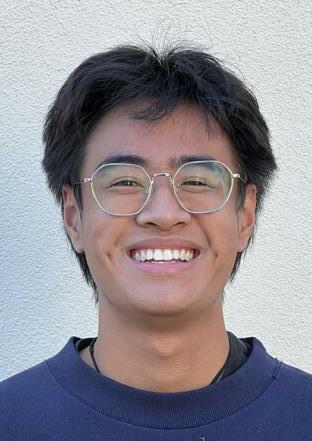
Gifts should express a mutual appreciation for the relationship built between both the recipient and the gift giver. Consequently, during the holiday season, it should be incum -
bent on everyone to give with care so that unnecessary waste is avoided, and the passion for gifting remains. Also, giving gifts is not the only way to express appreciation for a relationship. According to the Huffington Post article “This Is The Most Common Of The 5 Love Languages,” receiving gifts ranks the lowest out of the five basic love languages, behind physical touch, acts of service, quality time, and words of affirmation. As it turns out, there are valid alternatives that one can invest their time into this holiday season if gift-giving is not their expertise. Whether that is hosting parties with your friends, going out for dinner with your parents, or watching a long-awaited movie — there are plenty of options. Rather than being treated like an obligation during the holidays, gift-giving has the potential to remain the meaningful act of love it always was meant to be.
Mandate masks during wintertime, flu season
From sniffling to sneezing, we have all seen classmates exhibit telltale signs that winter and flu season, have arrived. Students were either quarantined or mandated to wear masks for the last two winters, but as preventative measures against COVID-19 relax, an increasing number of students are coming to school without a mask despite various viruses still being easily transmittable.
One way to help prevent common wintertime sicknesses is to establish an annual mask mandate at MHS for a few weeks before and after winter break. In the weeks prior to winter break, the weather gets colder and viruses spread easier due to cold weather making the body weaker at fighting them off, according to “Can Winter Make You Sick?” from Northwestern Medicine. If everyone wore masks throughout this period, it would be harder for viruses to propagate resulting in fewer people falling sick. Mask-wearing should also be mandatory in the weeks following winter break due to the possibility of students contracting viruses while traveling.
Although mask wearing was introduced to the U.S. due to the pandemic, it has been a cultural norm for years in many East Asian
countries in order to protect oneself and others from sickness, according to “Coronavirus: Why Some Countries Wear Face Masks and Others Don’t” by Tessa Whong from BBC News. While wearing a mask does not guarantee that one will not contract a virus, it offers a barrier that can slow the spread of bodily fluids, such as saliva or mucus, that carry bacteria.
according to “Largest Study on Masks and Covid-19 Demonstrates Their Effectiveness in the Real World” from Yale Economic Growth Center.
SANVI DURBHA

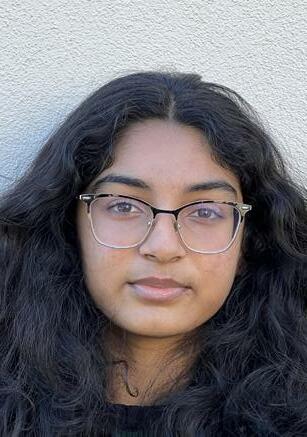
Without masks, ailments such as the cold, flu, strep throat, and of course, COVID-19, can spread extremely quickly in densely populated classrooms. At MHS, many classes have group seating with two or more people sitting mere inches apart from each other. Naturally, students will interact with each other, and without proper face coverings, an engaging conversation could result in being bedridden with the flu for days. On top of contracting sicknesses themselves, students could also carry bacteria home, possibly affecting family members, especially those already predisposed to illnesses such as grandparents.
In one of the first large real-world studies on the effectiveness of masks against COVID-19, free masks were distributed to 350,000 people in 600 villages in Bangladesh,
Through constant reminders to wear masks, explanations of the benefits of mask wearing, and distribution of masks by researchers during a oneweek period, mask wearing actually increased two weeks after the start of the study according to “Impact of Community Masking on COVID-19: A Cluster-Randomized Trial in Bangladesh” from science.org. It was found that symptomatic seroprevalence (the number of people who test positive for a disease) reduced by 9% overall and 11% among people who wore surgical masks. Although the research was done on COVID-19, it proves that mask-wearing protects against other wintertime viruses circulating our campus that can be contracted in a similar way.
While wearing a mask every day during this time might not be preferable for some, falling sick is much less ideal. Whether it’s a surgical mask or a KN95, wearing a mask to school for roughly a month during the winter is a small sacrifice to make in order to ensure a healthy winter season for everyone.
7 million students, or around 33% of all undergraduate students in the U.S., were enrolled in public four-year institutions during the 2020–2021 academic year, according to the National Student Clearinghouse Research Center. Nonetheless, total community college enrollment has been falling since 2011, and has dropped 3.4% from last year. I believe this is because community colleges are often understood by students as establishments specifically for the underprepared or unmotivated and a last
resort for everyone else. However, community colleges can be more affordable options as graduates enter the real world. From the very beginning of school, students are convinced by parents, teachers, and peers that there exists a hierarchy of education, especially in regard to colleges: Ivy leagues are at the very top, and community colleges are at the very bottom. Such academic elitism has a significant
negative impact on student’s college and career decisions, often resulting in immense student debt as students aim for popular, more expensive schools and regard community colleges as a shameful back-up.
At a school with a 95% graduation rate, some MHS students continue to equate and define post-high school success as “going away to col -

PRO DECEMBER 2022 THE UNION 2
Extended break provides rest to students, staff
Extended break reduces urgent learning time
overconsumption
Community college offers invaluable learning opportunities
SIDHANT BURELA
ANANNYA BHUSKAT
CONTINUED ON PAGE 3
ANGELINA BARNES
lege,” whereas attending a community college is relegated to a worst-case scenario back-up. Students around campus can often be heard joking about how shameful it would be to attend local community colleges if they are not accepted into private schools or University of California (UC) schools. This perception, together with a more relaxed admissions procedure at community colleges, creates the stigma that community college is an easy way out.
Community colleges, contrary to popular belief, provide a high-quality education in a non-competitive environment. They offer affordable tuition, local campuses, small class sizes, and transfer options to fouryear institutions. Students who initially enroll in community college have better transfer opportunities due to agreements
guaranteed by Associate Degree for Transfer (ADT) programs, which typically require two years to complete and either an associate in Art for Transfer (AA-T) and the Associate in Science for Transfer (AS-T) degree.
Students at MHS have some of the best local community college options. De Anza College, California’s sixth-best community college, has one of the highest two-year college graduation rates, and a 79% transfer rate and student admittance rate to the UC system. Programs like guaranteed transfers provide students an advantage over immediate admission to a fouryear undergraduate program by charging lower tuition and allowing students to work parttime and earn an income as well.
Furthermore, if Governor Gavin Newsom’s idea for dual admission in California, a part of legislation AB 30, is approved, the transfer process
will be significantly simplified. Under this law, beginning in 2023, freshmen in community colleges would be eligible for a guaranteed seat at the UC or California State University (CSU) university of their choice after completing their ADT. Starting in their first year of study, The project strives to increase students’ access to the resources provided by these universities in the first year of their study. Although the concept is still being developed, it is a step in the right direction for providing community college students with transfer options. Programs like these further debunk the myth that community college is the easy-way out and demonstrate that it is a viable option and useful stepping stone to the real world.
With so many opportunities, students should consider community colleges a legitimate option to pursue higher education.
EDITORIAL: The Opinion of The Union
Various pathways provide differentiated opportunities
At MHS, there are many students from various backgrounds and cultures, all with different career goals and ambitions.
Thankfully, MHS has successfully acquired more than enough resources to provide students with adequate career preparation. To accommodate students’ diverse needs, the school has partnered with several programs to offer various pathways so students can utilize their high school years to prepare for whatever professions they strive to achieve.
One convenient pathway available on campus are the academies, which are available to students in grades 10-12 and offer exclusive opportunities within required core classes, as well as specialized courses for students. The list includes the Digital Business Academy (DBA), the Engineering Academy, and the Travel and Tourism Academy. These academies work with colleges and universities to offer several opportunities and internships to students who plan to have future careers in these areas. MHS’ ability to offer such an extensive list of specialized classes on-campus
is admirable, as it allows students to make the most of their time at the school in regards to their future careers.
Another advantageous pathway is the dual enrollment program, which is available to juniors and seniors and works with the San José City College and Evergreen Community College District to offer college courses to high schoolers. The program allows students to take a few classes at select college courses at the community college locations in order to accumulate college credit before graduation. Dual enrollment is a great option for students who are looking to gain college credit but are undecided about their major, as the courses offered are preselected by the program.
Additionally, these courses are unavailable at MHS, so students can take the opportunity to learn about different career options or accumulate enough credits to graduate early from MHS and, later, college. This is a cost effective option that can greatly benefit students by allowing them to spend less time in college and save money.
Additionally, the list of path -
ways includes the worthwhile Silicon Valley Career Technical Education (SVCTE) program. Open to juniors and seniors, SVCTE allows students to take half their classes at MHS and the other half as a 3-hour course at the SVCTE campus in San José. The courses offered are extensive and hands-on, with specialized options such as auto body repair, dental assisting, and film and video production. Students do less book work and instead gain firsthand career experience, exposing them to the teaching styles of college professors. This is beneficial to students who would like to either start their careers straight out of high school or begin training before college. By offering this opportunity, MHS shows how much it cares for and wants to help all students succeed, regardless of what they plan for the future.
No matter what they may aspire to achieve after graduation, students have a variety of options at MHS thanks to these pathways. Through these programs, MHS has created an accommodating campus for all its students.
EDITORIAL: The Opinion of The Union
Reopen campus library, access to services
Hundreds of students walk past the empty school library each day, a desolate reminder of the abrupt end to an essential service at most schools. MHS has not had a librarian since the previous one resigned at the end of last school year. However, even without a librarian, the school must find a way to reopen the library as soon as possible, as it is indispensable to the growth of student self-sufficiency and collaboration on campus.
Because the library has been closed, students have missed access to the most fundamental educational service a library provides: books. Previous librarians did an excellent job updating the shelves with relevant, interesting titles. These books now sit untouched in the unused library, and students are missing out on significant learning opportunities. As MHS focuses on socio-emotional learning and wellness, the unmatched stress-reducing benefits of reading must be considered, according to the National Endowment for the Arts in an article titled “Why it Pays To
Read.”
Furthermore, the library’s physical space should be available for students, who would benefit from a quiet place to study before and after school and at lunch. Reservable study rooms allow students to collaborate on projects and study together. Simply having the space for students to make the most of their time or stay warm and read could significantly improve student learning and mental health on campus.
The library’s closure is as much a disservice to the student population as it is unprecedented. Even during distance learning, the library’s website remained a constant source of support to students, offering extensive research and college prep databases, online tutoring, and e-book services. While these services are all still offered, many students have yet to be connected, as with the closure of the library, communication on student resources was also terminated.
In addition, the printers in the library improve student
productivity and convenience. Currently, many students ask their teachers to print their assignments; teachers should not have to do this extra job. In a school with over 3,000 students, the loss of resources once readily available has not only placed the burden on teachers but also done away with the student agency and self-sufficiency a library could promote.
Of course, with a nationwide shortage of teachers, it may be difficult to find a librarian, but this is no excuse for keeping the library closed. When it rains, the administration opens the doors to the library so long as a teacher monitors the students inside. Perhaps, this same solution can be implemented during lunch and before and after school. Just as teachers are paid to conduct lunch monitoring, some can open and monitor the library for student use.
Learning, empowerment, collaboration, innovation, and respect are some of our school’s core values. Reopening the campus library reopens an essential resource for all MHS students.
SUBSCRIPTIONS
Yearly subscriptions to The Union are available for $25. Contact the Business Manager for more information.
Those who would like to advertise in The Union can contact the Ad Manager at milpitashightheunion@ gmail.com. Ads are available in full page, half page, quarter page, and business card sizes. Inserts are also accepted. Upon request, The Union staff will customize and design your advertisement.
CONTACT US
1285 Escuela Pkwy, Room E-9 Milpitas, CA 95035 Email: milpitashightheunion@ gmail.com
Riya Vyas • E ditor -in -C hi E f
Anannya Bhuskat • News Editor
Stephen Huang • Asst. News Editor
Satvika Iyer • Op-Ed Editor
Deeksha Venkateswaran • Asst. Op-Ed Editor
Tiffany Lieu • Features Editor
Savan Bollu • Asst. Features Editor
Sidhant Burela • Sports Editor
Erick Johnson • A sst. Sports Editor
Zaynah Turabi • Lifestyle Editor Albert Fung • Asst. Lifestyle Editor
David Rendon • Entertainment Editor
Varun Ravuri • Asst. Entertainment Editor
Sanvi Durbha • Spread Editor
Ruby Bui • Asst. Spread Editor
Angelina Barnes • Copy Editor
Sanvi Parvatikar • Web Editor
Adrian Pamintuan • Photo Editor
Kevin Ting • Business/Ad Manager
Sanjit Roy Journalism Advisor
HAVE AN OPINION?
3 THE UNION DECEMBER 2022
ADVERTISEMENTS
U NIO N STUDENT VOICE OF MILPITAS HIGH
The views in The Union are those of the writers and do not necessarily reflect those of the school, students, administration, or Milpitas Unified School District.
HAVE A GRIPE WITH THE SCHOOL? WANT TO PRAISE THE SCHOOL? WANT YOUR VOICE TO BE HEARD?
ALL LETTERS TO MILPITASHIGHTHEUNION@GMAIL. COM
NOT FORGET TO WRITE DOWN YOUR NAME AND GRADE
The Union is published by the Journalism class of Milpitas High School.
SUBMIT
DO
The WANT TO REPRESENT THE STUDENTS?
STAFF
CONTINUED FROM PAGE 2
EDITORIAL
Students kick back with unusual pets
By Varun Ravuri
When the topic of pets comes up, one often thinks of the traditional dog or cat. However, some students at MHS own pets a little out of the ordinary.
For senior Aarush Malik, his tortoise has been the perfect pet.
“I have a Russian Tortoise named Bamboo, who we have owned for about four years now in a terrarium in my house,” Malik said.

Bamboo is very low maintenance, Malik said. Besdies feedings and water soaks, Malik leaves Bamboo to freely roam in his backyard during the day.
“My tortoise has been a great decision because, while being low maintenance, he is also really friendly and loves interacting with people,” Malik said.
Bamboo has many quirks that Malik finds entertaining, such as attempting to eat anything green-colored because he confuses it for food, Malik said.
“Overall, I’d say my tortoise fits my needs perfectly because he brightens up my day, but does not require much of my time,” Malik said.
Bamboo has many quirks that Malik finds entertaining, such as attempting to eat anything green-colored because he confuses it for food, Malik said.
When someone thinks of chickens, they generally think farm animals, however Junior Geneva Deng owns four of them in her backyard.
“Our four chickens live in a coop, but are pretty much able to roam around all day,” Deng said


Deng’s family has owned chickens for about two years now and enjoys the company and easy-going nature of chickens, Deng mentioned.
“I do wish that I could spend more time with them, but whenever I can they definitely make my day a lot better,” Deng said.
The chickens are also a popular attraction among family and friends because they are very friendly and easy to handle, Deng said.
“I remember a time when I was really sad and sitting outside. It was as if the chickens knew what I was feeling, and they flew up to my table and sat down with me,” Deng said.
For over a decade Junior Jordan Althouse and his family owned a donkey. The donkey, Alexandra, wasn’t much maintenance, just needing to be fed and have room to roam.
“She lived in this big pasture made of wood that was constantly refilled with hay” Althouse said.

He often misses Alexandra, who died in August 2022, because she was the perfect companion in times of boredom, and he could even sit atop her at times, Althouse said. He would still be open to having another donkey, he added.
“I miss her and, while she may be considered unusual, I considered her an equal to any domestic pet,” Althouse said.
Not just exercise: Bikers form bonds on rides
sense of community for
“We always go exploring on our bikes together, to see around Milpitas,” Ro-
Junior Gabriel Su has also been able to build upon his tions with people life through his passion for
“I bike with my cousins a lot as a family,” Su explained. “It’s a hobby you can connect with.”
Biking also has the added benefit of being able to quickly pass the car traffic during school
“I think biking to school is really nice,” Su said. “There’s so much traffic in the morning and after school. It is better than walk-
Besides helping students avoid traffic, biking makes the ride to and from school fun,
“When you are biking, your own legs are controlling the whole thing,” Rodillas said. “You definitely have more freedom and you get to feel the air brush against your face.”
Students
By Angelina Barnes
return to great outdoors as science camp counselors, recall fond memories

Jose.
Many students have fond memories of elementary school science camp, where they participated in activities in the wilderness away from school and their families, as some of their fondest memories from childhood. Many juniors and seniors volunteer a week of their time to serve as science camp counselors for local elementary schools.
Senior Jesse Villahermosa attended Camp Loma Mar in elementary school and decided to go back during his junior year to serve as a counselor, he said. He went to science camp with students from Rose Elementary and two private schools from San
“The elementary school kids talk a lot, and they’re really stubborn,” Villahermosa said. “If you start off being kind of strict and hard on them, they start to understand that you’re not just playing around, and by the middle of the week it gets way easier.”
Senior Mia Rodriguez was also a science camp counselor last year and remembers the long list of tasks and responsibilities she was given, she said.
“You get them ready for breakfast, activities, lunch after their activities, dinner, and at the end of the day you get them ready for bed,” Rodriguez said.
Villahermosa said his favorite memory was spending time with
the other counselors.
“During breaks, when we weren’t involved with the kids, the counselors would just sit in a circle on the benches a little further away from camp,” Villahermosa said. “We would just sit there and talk because that would be the main time for us to talk to each other.”
Rodriguez said her favorite memory took place on the last day of science camp with her group.
“I let them pillow fight each other before bed,” Rodriguez said. “We got caught and ended up getting in trouble, but it’s okay. I enjoyed my time with them.”
The hours spent taking care of others can be rewarding, Villahermosa said. MHS capped the
number of community service hours a student can receive for being a counselor at 100 hours in recent years, he added.
“They give you a review sheet so that you understand how well you did, but if your trail group leader thinks that you didn’t do that good of a job, the amount gets reduced,” Villahermosa said.
The application process to be a science camp counselor is also relatively straightforward, making it an easy way for students to earn community service hours.
“You just have to fill out a form to apply to both the school and the website of the camp you want to go to,” Villahermosa said. “There’s paperwork, including shots and updating any other
health information or stuff they would have to worry about.”
Although the high school students are responsible for monitoring the younger students during their activities, they are also allowed individual time during the day to complete their independent work for school.
“They’re really limited in terms of using technology. You have to use their computers to complete any work, and most of them are restricted to school-related websites,” Villahermosa said. “I didn’t really have to do my homework because my teachers didn’t assign that much. If you have paper assignments, then you should be fine. You just need to find the time to do it.”
DECEMBER 2022 FEATURES THE UNION 4
Seniors Villahermosa and Rodriguez volunteered to be science camp counselors at Camp Lona Mar, where they guided elementary school students and bonded with other counselors.
Courtesy of Francois Dermu
Courtesy of Aarush Malik, Geneva Deng, and Jordan Althouse
Sanvi Durhba | THE UNION
Malik’s tortoise, Deng’s chickens, and Althouse’s donkey (left to right).
Behind the stop sign: Crossing guards recollect experiences
By Adrian Pamintuan
For many students, the school day begins and ends when they pass the crossing guards who direct students at almost every school entrance. Whether students wait to cross the street on foot or in a car, they find themselves in interactions with these yellow-vested, sign-wielding essential workers daily.
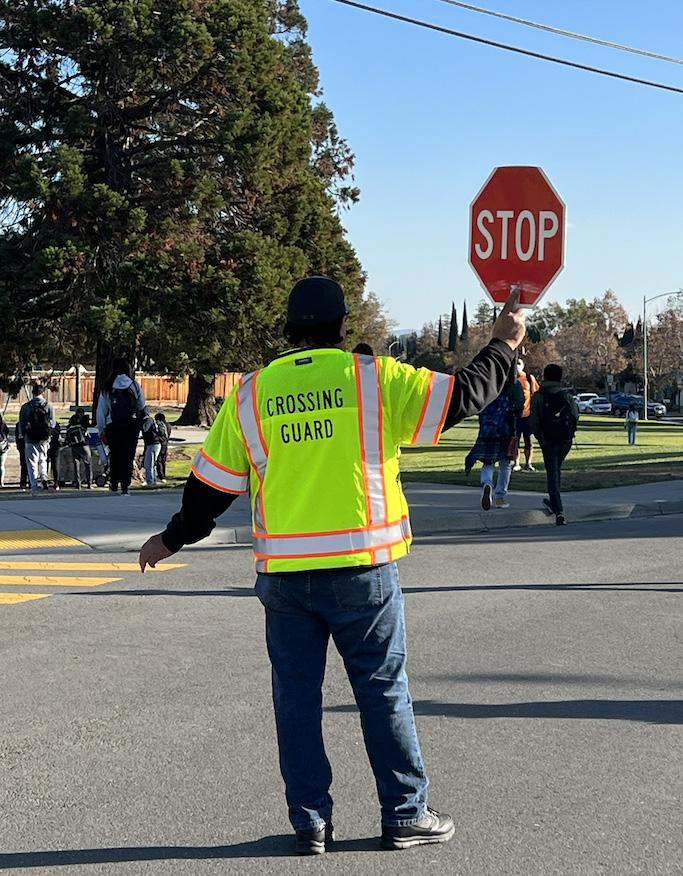
Reynaldo Lingad is a crossing guard positioned at the crosswalk which adjoins the MHS student parking lot and Marshall Pomeroy Elementary School.
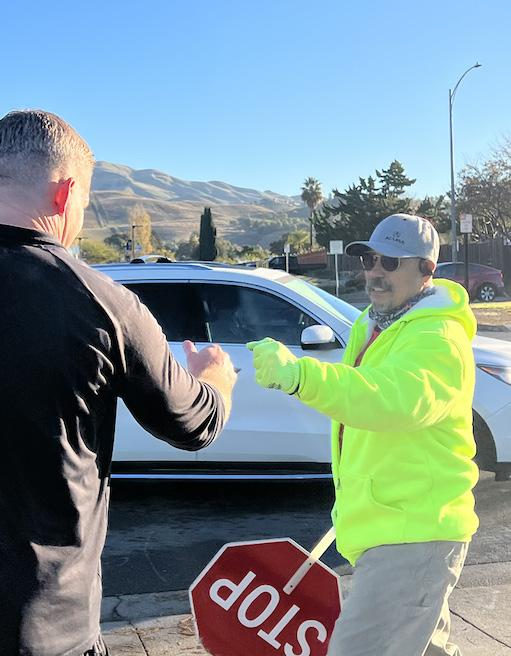
“In 2007, I retired from my government job,” Lingad said. “And I said, ‘I want to do this; I want to be a crossing guard.’ So next thing you know, I started loving it because I love people.”
Lingad is an ordained pastor at the Spring Valley Bible Church, and sometimes the church members go on mission trips, he said.
While on a trip to the Philippines, he met with indigenous mountain people called “Aetas,” he said.
“We proclaim the gospel to them, but in the meantime, we give them help – for example, rice, or something to supply them with,” Lingad said.
Lingad has come to look forward to the many students and parents who show respect and appreciation for his work as a crossing guard, he said.
“Every December, Christmas time, or every February for Valentine’s Day, I get so many gifts,” Lingad said. “So I know that they
love me here.”
Having been on the job for 12 years, Lingad said that his experience has made most of his tasks automatic. For example, he learned to memorize the routes each student has to take or which of their greeting gestures he should reciprocate, he noted.
Junior Therese Sanchez said she passes by Lingad on her way to school and exchanges peace signs with him. Ever since the first time she gave the gesture, Lingad always has given her a peace sign back, Sanchez said.
“It’s a little part of my day that’s consistent, but a good thing,” Sanchez said. “They’re always there, rain or shine. They’re always helping students, and you can tell they actually care about us,” she said.
Ismael Gutierrez works as a crossing guard at the intersection of Escuela Parkway and Russell Lane. While Gutierrez had happy experiences to share, he also disclosed the tough moments crossing guards face while out on the road.
“This one lady just started screaming at my co-worker, calling her names,” Gutierrez said. “And (the co-worker) got really upset. She just told me ‘You know what, I’m done. I’m not going to come out here anymore.’ … I went and got her flowers the next day and she never came back.”
Lingad said that he chooses to disregard those giving him a hard time, and instead begins each day praying that they simply stay out
of harm’s way.
“I always tell myself, ‘Let not these people steal my joy,’” Lingad said. “When bad things happen, I just smile and say, ‘Have a nice day.’”
By coaching a little league for his son and grandson, both MHS graduates, Gutierrez has familiarized himself with the community, he said.
“The kids — I got used to them. The little ones saying ‘good morning,’ ‘thank you,’ ‘see you tomorrow’ — they even tell me ‘stay safe,’” Gutierrez said. “The kids are the ones that keep me going.”
Gutierrez spent 3o years working at a Fremont glass company as
how to get a credit card, or how to shop for lower interest loans,” Cummins said. “It’s really sort of heartbreaking. As a society, we haven’t done this very well,” he said.
He also sees students that use popular investing apps like Robinhood, that have enticing user interfaces, clicking away at stocks without putting much thought into it, Cummins added.
“Robinhood is fine, except it’s almost like it’s you’re on DraftKings or whatever the other gambling apps are because no one’s really stopping you,” Cummins said. “Humans need friction to make big decisions like this. They need it to be more difficult than that.”
Investment possesses advantages, risks
 By Albert Fung
By Albert Fung
From stocks to bonds, mutual funds to exchange-traded funds (ETFs), and cryptocurrencies galore, financial investments have grown in popularity in the last few decades, in part due to influence from financial gurus such as Warren Buffet, Dave Ramsey, and Robert Kiyosaki. According to an estimate from the Don’t Quit Your Day Job company, 2019 saw over 13 million accredited investors in the U.S., an increase of roughly 35.2% since 2013. With so many active investors and experts raising the awareness of personal finance, it is natural for ordinary people, including high school students, to be intrigued about whether or not they should invest their money.
In early 2020, senior Aaruni Gupta decided to learn about investing and try out paper trading, the use of computer simulation software to simulate the real stock market, he said. Several months later, he began his journey into the real stock market, Gupta said. At first, he took too many risks, and thus, his overall
gains were minimal, he said.
“When I was first getting into stocks, I did options without understanding how risky they actually were,” Gupta said. “I didn’t understand how you could lose everything in options within minutes.”
As time went on, Gupta became more comfortable with the stock market and his risks went down, he said. Aside from stocks, Aaruni also made one investment in cryptocurrency, though he strongly regretted it, he said.
Nonetheless, he still recommends students to begin investing as soon as they can.
Students should start investing as soon as possible, said longtime investor and social science teacher Michael Cummins. However, students might find it difficult because the United States does a poor job of teaching students the financial literacy skills needed to make the right investment decisions, Cummins said.
“Alumni still contact me from time to time wondering why they never learned how to balance a checkbook, do a budget,
Social science teacher Roy Huang said students who chose to use these platforms must think clearly about the choices they make. More specifically, they must keep in mind how brokerages make money, he said.
Payment for Order Flow (PFOF) is the compensation for a brokerage, a firm that acts as the middleman between buyers and sellers, which works by routing orders for a trade execution to a market maker, according to Investopedia. Oftentimes, PFOF is criticized for taking advantage of investors by seeking to create potentially unfair conditions, such as providing overly and unnecessarily high execution prices for customers, according to Investopedia.
Cummins’ advice for any student who may be interested in getting started with investing is to ask a parent to set up a joint account in which both the child and the parent can invest together, he said.
“Start today and then the behavior of cash is actually even more important. Can you, when you have your job at whatever –you’re at Jamba Juice working or Chick-fil-A – when they give you a $100 paycheck, can you put 50 of those dollars somewhere that will help your future?” Cummins said.
a certified welder, and waking up every morning to help students cross the street has continued to keep him active after retirement, he said.
“I know this spot already,” Gutierrez said. “I know who all the people are and all the kids. If I don’t go back, I don’t know who’s going to take my spot,” he said. “I got attached to the kids.”
The crossing guard’s effort to personalize every interaction with students is what Sanchez appreciates most about them, on top of keeping everyone safe, she said. Students should thank the crossing guards for what they do everyday, she added.
“I know the G building crossing guard uses the same beanie every single day. What if we get him a new one or something — stuff they’d appreciate?” Sanchez said.
Gutierrez said that no matter the struggles of being a crossing guard, the students he meets and the small affirmations he receives tends to balance out the struggles — which he said owes to his time in the role over the years.
“I’m having a good time doing this,” Lingad said. “I mean out of 1,000, probably 0.01% bad (experiences) … 90% of the parents and the students know me here; they know me as a smiley person,” Lingad said.
Theater design presents showcase
By Erick Johnson
The MHS theater design class held a showcase event at 3Below Theaters in San José on Nov. 20, where they presented the artwork of several current and past students, according to theater director and theater design teacher Kaila Schwartz. The event was part of San José Playhouse’s “Sunday in the Park with George’’ musical, aimed at celebrating and showcasing local artists by displaying their art, according to the San José Playhouse website.
San José Playhouse contacted Schwartz about hosting an exhibition, Schwartz said. She jumped at the opportunity for her students to get the recognition they deserve for their work, she added.
“I thought this would be a really cool opportunity to put our high school name out there in public outside of the Milpitas community so that they can see some of the awesome things that we’re doing here,” Schwartz said.
Headlining the event was junior Mallika Ghante, who was the artist behind most of the art, which was displayed before and after the musical, as well as during intermission in the exhibition hall, Schwartz said. An entire room was dedicated dents’ work, “We’ve done set ing and prop making. I designed a set for ‘Chicago,’” Ghante said.
“And for prop designing we had to do an alien project where we designed food or instru ment props for

an alien play.”
Additionally, according to Ghante, she designed abstract set designs, and three-dimensional steampunk styled art made on a computer software. She also worked on a multi-colored lighting system for her miniature “Chicago” set.
“I could see that people were really impressed by what was going on in our theater design class especially since like in San José, not a lot of people know about Milpitas High School and what we do in this design class,” Ghante said.
This event was a big breakthrough for the theater design class, Schwartz said. She wanted her theater design students to feel appreciated and be awarded just like her acting students, and the event is a step forward for them to be recognized as artists, she added.
The theater design class has only existed for five years, and their San José exhibition featured art from classes throughout the years, Schwartz said. Being the class’s first big event, it proved to be successful, she added.
“It was received very well,” Schwartz said. “Some of the patrons who came into the exhibit were blown away by our students.”
Ghante said this event was a breakthrough for the school’s theater department, but it is also the beginning of her career as a thespian. This event helped her create a new identity within the art and theater world, because it was her first time showcasing her art publicly.
“Being in this class gave me a network of people I can rely on after I graduate,” theater design student
said.
Gabriel Carreon
DECEMBER 2022 THE UNION 5
Courtesy of Mallika Ghante
FEATURES
Students and teachers discussed their perspectives on investing early.
Courtsey of Charles Schwab
Reynaldo Lingad (left) fist bumps a pedestrian. Ismael Gutierrez (right) guides students across the street.
Adrian Pamintuan | THE UNION
An alien designed and created by Ghante is displayed at the showcase.
K-pop, hip-hop, lion dance teams build groovy communities
By Zaynah Turabi
Whether it be at performances during school events or just practices after school, it’s not uncommon to see students on dance teams around campus. Dance has existed as a form of expression across different cultures for centuries. It brings people together and offers different interpretations of music across the globe. At MHS, many students take part in the activity by joining one of the several dance teams on campus. These teams range from Korean Pop (K-Pop) dancing to traditional Chinese lion dancing to modern hip-hop. With so many styles and communities, there’s a dance team for everyone, no matter their background, skill, or interests.
An especially popular music genre today is K-Pop. According to the On One Studios article “From East to West: A Brief Guide to K-Pop Dance History,” K-Pop originated in the 1950s with distinct dance styles, but as the style became heavily influ-
enced by Western music styles, the K-Pop routines of today have gained international popularity.
One of the teams at MHS is the Korean Dance Team (KDT), a student-led dance team formed in 2012, according to KDT president Alan Ngo.
“Our dance team is KDT,” Ngo said. “We usually cover K-Pop dances. We perform together and send out invites, and as for performers from MHS,” he said.
KDT currently has approximately 50 club members, and no prior knowledge is necessary to join, Ngo said. With weekly workshops for bonding and performances, KDT provides a comfortable environment for students to share their love of K-Pop, Ngo said.
“It’s a club to form unity because we all love K-Pop,” Ngo said. “We all love to dance, so we can share common interests with one another,” he said.
The traditional Chinese lion dance is another style that performs on campus. According to the New World Encyclopedia ar-
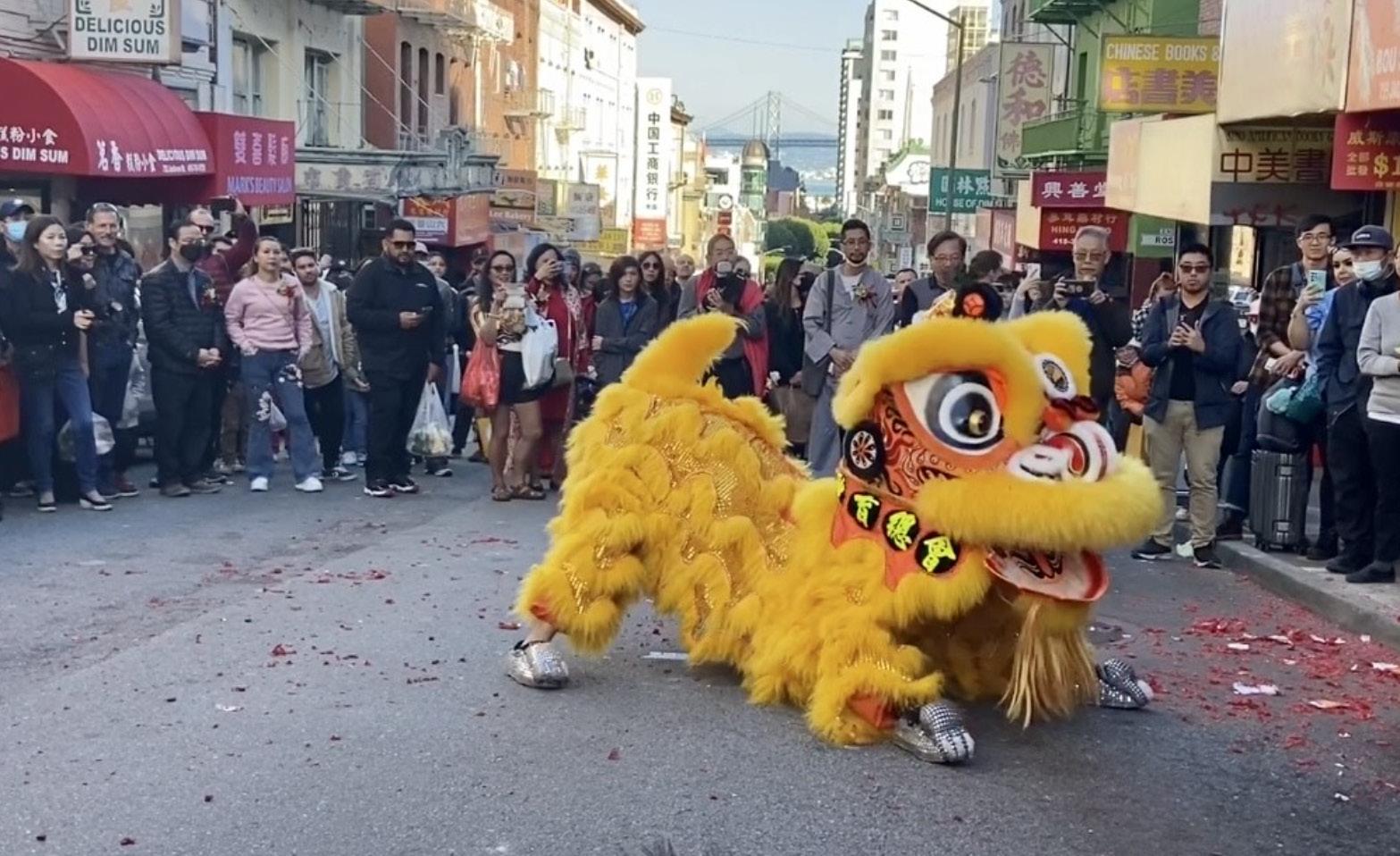
ticle “Lion Dance,” the style originated sometime before the Tang Dynasty, which took place from 618 to 907, from various folktales
that centered around lions. Since lions were not native to China, the dance style was influenced by the movements of other animals, creating a unique result, the article said.
The MHS Lion Dance Club is new, having started this school year, according to club founder and president Timothy Tran. The team focuses on the traditional style of dance, which was not previously offered, Tran said.
“It’s a cultural dance, and it’s based off of Chinese Culture,” Tran said. “I was originally in a lion dance team, and I wanted to bring it to my school,” he said.
The Lion Dance Club is open to all students, with around 20 current members and two lion costumes, Tran said. At weekly practices, students can both dance in a lion costume and help with the musical composition, which includes drums, cymbals, and a gong, Tran added.
“Lion dancing is a pretty unpopular sport, especially in the United States,” Tran said. “I wanted to find a way to spread it, and the best way I thought I could do it is by starting a school club.”
A more recently devel-
oped style is American Hip-Hop. According to the BBC Arts article “The History of Hip-Hop Dance,” Hip-Hop began in the 1970s in New York City, but the genre later evolved as both East and West Coast styles merged to encompass a wide range of styles and dances that have culminated into today’s practice.
MHS is home to the Hip-Hop dance team Milpitas Misfits. Established in 2015, the team specializes in urban Hip-Hop dance styles with both pop and rap music, co-president Johnny Nguyen said.
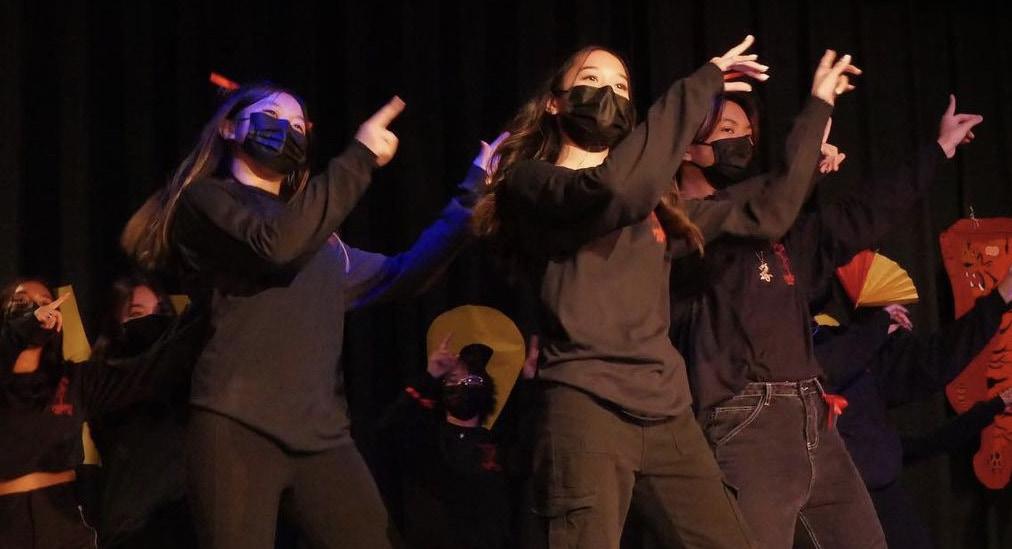
“It was just a way to get people who love dance, especially hiphop, to be able to come together and just have fun and dance together,” co-president Evy Nguyen said.
Milpitas Misfits has approximately 30 members and is open to all students with no experience required. The team has weekly practices for members and mainly performs at school events.
“I just want the members to have fun,” Johnny Nguyen said. “Don’t be discouraged if you can’t do the moves. That’s why we’re there, as a cabinet, to help you.”
Students reflect on midterm election results, discuss policy implications
By Ruby Bui
Election Day, held on Nov. 8, 2022, resulted in victories for Governor Gavin Newsom, state Senator Aisha Wahab, U.S. Senator Alex Padilla, and Milpitas Mayor Carmen Montano. Following the finalization of the election results, MHS students shared their thoughts and opinions regarding the winning candidates.
“Our state of California always has major changes and pushes to be better every single year, and I think that won’t change with the new selection of people,” senior Derek Phan said.
Newsom, who was elected as California Governor in 2018, won his second term in this year’s election with 59.3% of votes, while his challenger Brian Dahle received 40.7% of votes, according to the Associated Press.

environmental issues already. For example, he’s done protection programs to help forest fires.”
There were setbacks during Newsom’s first four-year term, but he has yet to meet failure, Phan said.
“He changed laws in the criminal justice system, having people that are ill or incapacitated in prison be released,” Phan said. “I think that’s a humane thing to do because, at the end of the day, they’re still human too.”
However, Newsom tends to have “band-aid solutions” to many deep-rooted problems, and could be more progressive in his actions and policies, junior Nidhi Bhat said.
“There was a rally for ethnic studies to be mandated in public schools, and Newsom vetoed that bill,” Bhat said. “That was what turned me away from him be cause there are a lot of willfully ig
so mandating a class like that would open peo ple’s eyes to the
that exist in our society.”
Before Newsom signed Assembly Bill 101 which requires high school students to complete a one-semester course of ethnic studies to graduate, he initially vetoed it, according to EdSource.
Wahab was elected state Senator of District 10 for both Alameda and Santa Clara counties this election, making her the first Afghan-American and Muslim woman to be elected to public office in the U.S., according to ABC7.

“Diversity in politics brings attention to a lot of problems that not everyone sees and that’s a good thing,” Phan said. “You see the problems that may be minor for other people, but are major for marginalized groups.”
Wahab’s advocacy for housing control, expansion, and improvement is admirable and seems to reflect her experiences with be ing an immigrant and a foster
“Her campaign wasn’t funded by big corporations and big money, so it was all funded by the people, which is respectable,” Bhat add ed. “She focuses on
shouldn’t be rare, but it’s rare among politicians nowadays.”
Additionally, Padilla, the first Latino U.S. Senator from California, was reelected for a second term. He pushes for progress on important issues like voting rights and job opportunities, Phan said.

“When supporting a politician, I look for leadership and strong communication in a candidate,” Moncada said. “Many senators don’t have a strong connection with the people of their state,” he added.
Padilla’s election will positively impact immigrants, people of color, and others that are disadvantaged in society, Bhat said. She strongly aligns with his progressivism, she added.
However, Montano, the winner of the Milpitas mayoral election, wasn’t who Bhat had hoped to win, as she supported can didate Karina Domin guez, Bhat said.
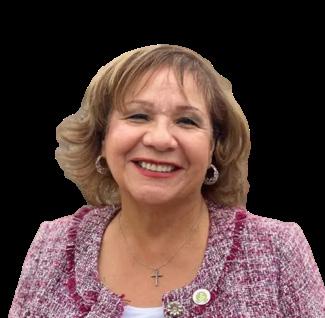
“Mayor Mon tano wants to expand Bay Area Rap id Transit (BART) and have a better bus system,
which is great. I think it’s one of the biggest things Democrats need to focus on, especially because having walkable cities and good public transport can improve the quality of life,” Bhat said. “But I disagree with her recent accusation of accepting travel money and not disclosing her finances, which is contradictory to the character that she presents.”
Resident Chris Martin accused Montano of violating the limit in accepting a travel gift and trying to conceal the truth, according to “Complaints made to the District Attorney and FPPC against Vice Mayor Montano” by Maria Denise Cuenca and Rhoda Shapiro.
Generally, people have different standards for an ideal candidate. What makes an excellent candidate is to have a great deal of experience with the people of their community and to fully understand the struggles and problems that are present, Phan said.
DECEMBER 2022 FEATURES THE UNION 6
Lion Dance Club members Karina Kwok and Cindy Nguyen perform a dance in San Francisco Chinatown.
Courtesy of Timothy Tran
Milpitas Misfits members dance in matching black outfits at the 2022 Lunar Show, hosted by Chinese Club.
Courtesy of Evy Nguyen
Courtesy of Getty Images
Courtesy of The Milpitas Beat
Courtesy of Aisha Wahab
On Nov. 8,
Courtesy of Rich Pedroncelli
2022, Newsom was reelected as governor, Wahab elected District 10 state senator, Padilla reelected U.S. senator, and Montano
elected Milpitas mayor (left to right).
‘An exceptional woman’: Annie Handy recounts life of teaching, social justice
By Tiffany Lieu
Annie Handy has been a constant presence at MHS as a substitute teacher for the last two decades, and many students have heard countless stories about her life. Though, Handy was still in the classroom before substitute teaching, working as a teacher at East Palo Alto for 12 years and later at Marshall Pomeroy Elementary School for 22 years, she said.
Prior to teaching in California, she taught at a school in Louisiana for three and a half years — in the same state where she was born and raised in a family of 13, Handy said. Segregation was still in effect when she was growing up, and she attended all-Black schools, which were the worst of the schools, she added.

“I come from an area in the South where life was tough for African American people,” Handy said. “That’s why I’m still work-
Some students feel left behind by buses
By Savan Bollu
Valley Transportation Authority (VTA) school tripper buses, lines School 246 and School 247, are designed to provide transportation for students to and from Milpitas High School, according to Santa Clara VTA public information officer Stacey Hendler Ross. VTA collaborated with MUSD to determine the school tripper routes and how many buses should be offered, she said.
According to the VTA website, there are three School 246 buses and one School 247 bus every day after school.
These buses often fill up to maximum capacity and leave earlier than scheduled after school, forcing students to wait for a later bus or find another way to get home, said junior Maryam Mohamed, who rides the School 246 buses. She often gets turned away from the first two 3:33 p.m. and 3:40 p.m. buses because they fill up immediately after school, and she either has to wait over 30 minutes for the last bus at 4:15 p.m. or ask her parents to pick her up, she said.
“The moment it (the bus) gets there, it gets full because there are so many kids who are trying to ride it,” Mohamed said.
Students sometimes even ask their teachers to leave class a few minutes early so they can get on the bus, said senior Abira Rahman, who takes the School 246 buses.
Mohamed reported the inconsistent schedule to VTA customer service last school year but saw no significant improvement, she said.
Senior Afnaan Waqas said he rode the School 247 bus every day last year and occasionally rides it this year. The bus consistently leaves early, he said.
“It leaves right as school ends or sometimes even before the bell rings,” Waqas said. “I know for a fact that I get here (the bus stop) within a minute (after school), and sometimes I have to run to catch the bus — and it’s already down the street.”
The bus is usually overcrowded, he added.
“If you don’t get there within the first minute, you’re either going to have to get squished between 10 other people right next to the door, or you might not even get a spot inside,” Waqas said. “Sometimes they just say, ‘Nope, we can’t take any more people.’ That’s definitely an issue.”
When Waqas can’t get on the bus, he waits at the bus stop for around an hour for his parents to leave work and pick him up, which wastes time, he said. This year, he switched to riding a bike home after school partly because of the bus’s inconsistency, he said.
“With my bike, I get to control when I can go and leave, so I don’t need to worry about the bus showing up late or early,” Waqas said. “I can just grab my bike and go.”
For Mohamed, when the bus leaves early, she misses extracurriculars after school or is unable to make it home in time for prayer, she said.
“I remember that once, I was really depending on the bus to take me home for that (the prayer time),” Mohamed said. “But I had to call my parents because I
ing — to let the kids know how good they have it and to make good use of it.”
Although her parents had to work the worst of jobs, they were still able to provide for Handy and her siblings, she said.
“We were able to make it,” Handy said. “We always had a meal. We never went hungry, and we got to participate in school activities.”
After graduating from high school, Handy attended South-
ern University in Baton Rouge, a historically Black university, she said. She participated in the first Civil Rights Movement march in Louisiana organized by Martin Luther King Jr. to fight for integration, Handy said.
“For me, it was very scary, but I did it anyway,” Handy said. “We just marched for equal rights in the South, in Louisiana. And I still feel good about it. I still tell my stories in the classroom here.”
Following her college graduation, Handy started working in an all-Black public school and later moved to California for a better life, Handy said. She then got married and had two children, she said.
Handy’s daughter Tarsha Stewart said that Handy was dedicated to her grandchildren, sometimes even putting them before her own children.
“She talks about them to everyone, not just kids at the school,” Stewart said. “Whoever she interacts with, she talks about them. It’s like a badge of honor that they’re doing well.”
Handy’s example taught Stewart how to be a better mother, Stewart added.
“She’s an exceptional woman,” Stewart said. “My mom would go without sleep. She would make sure dinner was cooked every night. She consoled us. It was like she was the mom, the teacher, the social worker. (She) would help deal with any issues that we had. I have so many fond memories. I had a privileged childhood, I would say. I never went without. She just was exceptional.”
Stewart once threw a birthday party to honor her mother and would never forget the smile on Handy’s face, she said.
“Last year, I decided to throw her a birthday party, and my mom never had a birthday party ever in her life,” Stewart said. “So I threw her a 79th birthday. And people would ask, ‘Why 79? 79 is not significant.’ But after going through COVID and people losing loved ones, I’m like, ‘I need to celebrate
my mom now. I’m not going to wait until these supposedly milestone birthdays.’”
Handy used to bowl, loves going to church, and has been involved with organizations such as the National Association for the Advancement of Colored People (NAACP) and the Black Alliance, Stewart said. However, teaching itself is also one of Handy’s hobbies, Stewart added.
“Substitute teaching keeps her active, keeps her young,” Stewart said. “It helps her be a better grandmother to my kids.”
Handy was also involved with MHS’s Black Student Union and served as a mentor figure, MHS alumnus Nyla Choates said. Choates always appreciated having support from staff members in the district, Choates added.
“She always supported us with the Black History Month showcase,” Choates said. “We would have our Black History programs every Saturday, where Chris Norwood would come and Ms. Handy would also come, where they would teach us some Black history that they weren’t teaching us in school.”
Handy also supported Choates’ more recent initiatives, such as her children’s book release, Choates said. She gifted a copy of her book to Handy because of how uplifting Handy always was, Choates added.
“Every single time I walked into the classroom, she would just always make sure to let me know that my hair was beautiful, and I don’t think she knew how much of an impact she was making,” Choates said. “She always made me feel like, ‘Okay, maybe I do look good,’ because sometimes you have that self-doubt when you look different than everyone else.”
While Handy may have come off as stern, the “tough love” she showed was necessary and came from a place of care, Choates said.
“She truly has the warmest heart,” Choates said. “She really does want the best for you.”
couldn’t trust the bus would come when it was supposed to come.”
Sophomore Hanah Edwin, who rides the School 246 buses, said her mom works and cannot pick her up after school, so when the bus leaves early, she goes to the Milpitas Library or waits at the bus stop for a close relative to pick her up.
“It can be dangerous to stay here all alone, especially for women,” Edwin said. “So I would say that the biggest issue is just safety, especially in the wintertime when it starts to get dark early.”
Rahman, who also takes the morning School 246 buses, said that the morning buses have not been showing up, leaving students without transportation to school. As a result, Rahman has nine tardies to her first period, she said.
The VTA website recommends
using the bus-tracking app, Transit, for “up-to-the-minute” accuracy on arrival and departure times.
However, the app is unreliable, Rahman said.
“Sometimes it (the app) says, ‘Oh, the bus will come in eight minutes,’ and it just never shows up for the day,” she said. “I either have to ask my dad to drop me off at school, or I have to take two buses to school — a bus from my house to the BART station, then from the BART station to school.”
When asked about why the buses sometimes don’t show up, Ross, the VTA public information officer, said that it could be due to an overall shortage of VTA bus operators.
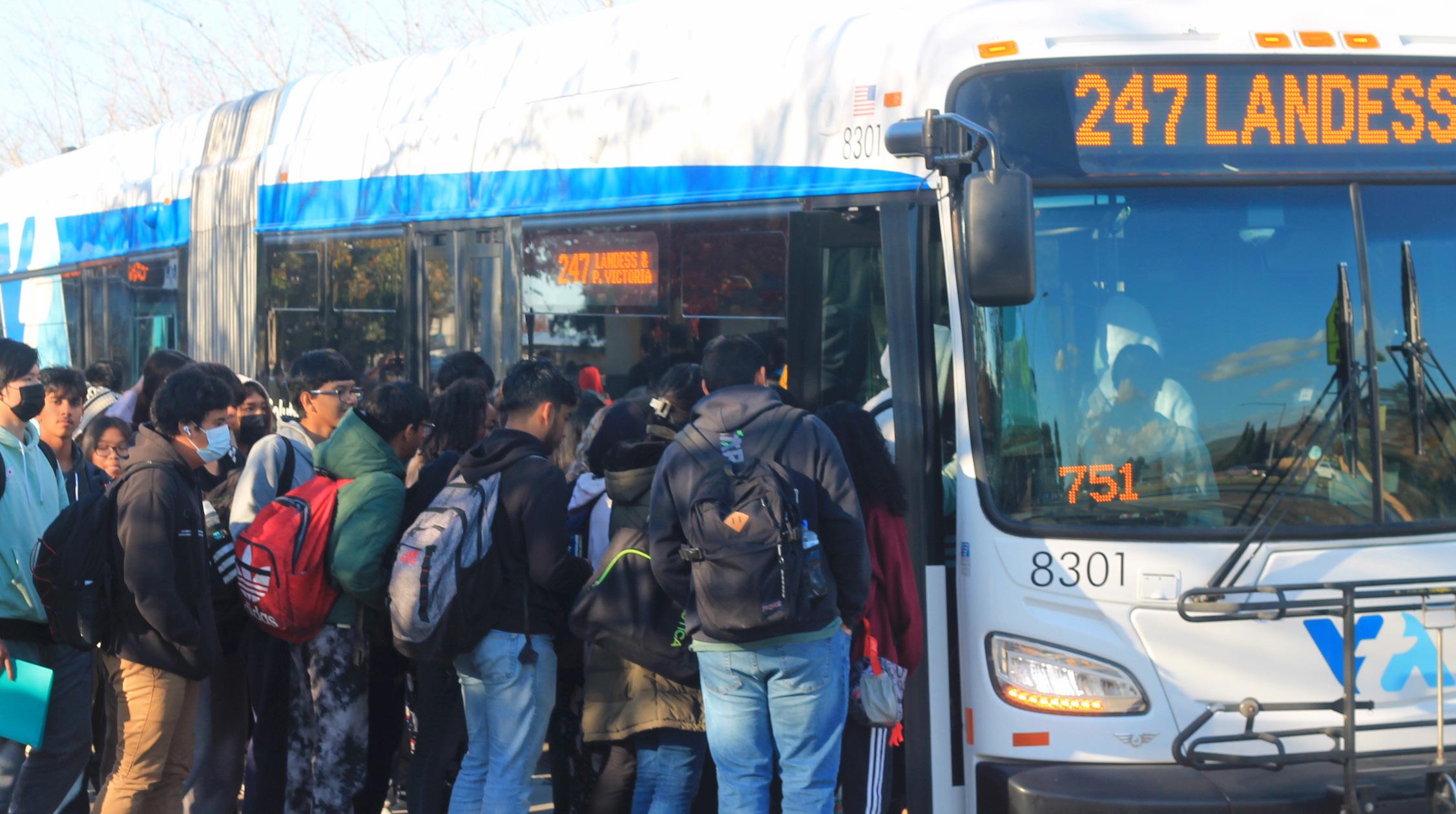
“If we don’t have enough bus drivers, and someone calls in sick or someone can’t make it to work that day, for whatever reason,
then there’s a potential that we may miss that route or the service may change somehow,” Ross said.
VTA has not received any reports complaining about the school tripper services from students or bus operators this year, Ross said. She recommends that students call customer service if they have experienced problems with the VTA buses.
“Let us know because we certainly don’t want to leave students behind,” Ross said. “We’ll do everything we can to try and revise our service so that students can get the transportation they need.”
The customer service number is 408-321-2300, she added.
“Because we’re paying for the bus, it should be a quality service,” Mohamed said. “And the bare minimum it should do is actually take us home.”
FEATURES DECEMBER 2022 THE UNION 7
Annie Handy and her daughter Tarsha Stewart visit Roanoke, Louisiana, the city where Handy grew up.
Courtesy of Tarsha Stewart
Crowd of students line up to board the School 247 bus at Escuela Parkway and MHS after school on Dec. 7.
Savan Bollu | THE UNION
Gift sustainably: Resourceful alternative packaging
 By Tiffany Lieu
By Tiffany Lieu
For many, thinking about the holiday season invokes images of tearing colorful wrapping paper and bows off of gifts. However, the joy of these moments is often outshined by the pile of paper and plastic left behind after all presents have been opened. Luckily, there are still many ways to give beautiful gifts to loved ones without sending more waste into the landfill.
1. The easiest option: reusable bags This option may already be a go-to for those that don’t like wrapping presents. Paper gift bags come in a various styles and can emulate the same glamor of wrapping paper with a key difference — the bags can always be reused or recycled. An even more sustainable alternative is packaging gifts in reusable cloth bags. These bags can be found in a wide variety of sizes and patterns, or you could even sew one yourself. Not only is this option super simple, but reusable bags are also extremely versatile and will be able to live on as shopping bags, storage, or packaging for future gifts.
2. A twist on wrapping paper: reusing newspapers and magazines

If you still love the look of paper wrapped crisply around a box, consider using an old newspaper or magazine. You don’t even need buy anything; a copy of The Union itself could be used to wrap your next gift. Tradi tional wrapping paper with spar kly details and plastic tape cannot be recycled. Even worse, the tiny pieces of glit ter can end up in the stom achs of wildlife, according to “It’s Officially Time to Ban Gift-Wrapping Paper” by the Huffington Post. If you still need something to keep your wrap ping in place, you can spruce up your gifts by securing them with a ribbon or washi tape — a type of tape that is typically made from compostable and recyclable materials according to “Your Eco-Friendly Gift Wrap Guide, From Knot Wraps to Washi Tape” by the Huffington Post.
If you want to take it one step further, take inspiration from the New York Times article “Top a Present With a Newsprint Bow” and make snowflakes and bows out of repurposed paper to attach to your present. If you happen to have spare magazines or newspapers, the holidays could be a great opportunity to put them to good use!
3. Two gifts in one: wrapping with fabric
For a more elegant look, you can utilize a scarf or other spare cloth, allowing the wrapping to become its own gift. This method takes inspiration from furoshiki, which are traditional Japanese cloths that have been used for centuries to carry belongings or wrap presents, according to “Furoshiki Gift Wrapping Makes My Christmas Gifts Much More Sustainable” from The Strategist. An online resource titled “How to Use ‘Furoshiki’” created by the Japanese Ministry of the Environment details many different ways to fold the fabric around your gift. While a variety of stylish knots can be used, one of the simplest of these methods is yotsu musubi, which involves simply tying opposite corners of the fabric to each other in order to wrap the gift. Much like wrapping paper, fabric comes in a large variety of colors and patterns and can be further customized with details such as embroidery.
If all else fails, the best way to reduce waste is to not wrap your gifts at all. It doesn’t matter how fancy your presents look — what matters most about the holidays is the people you spend them with and the memories you make.
Students celebrate various winter holidays
The moment the clock strikes twelve on Dec. 1, Christmas cheer fills the air. Storefronts are stocked to the brim with presents, the overwhelming scent of cinnamon wafts through bakeries, and ASB plans Christmas themed events to boost school spirit. Christmas has always been in the limelight, but what are festivities like for people who celebrate other holidays during the winter?
Many students celebrate other cultural or religious holidays during winter break, such as Hanukkah, a Jewish holiday celebrated annually for eight days during December. It commemorates a historical event from 139 BCE in which a menorah (a nine branched candle holder) lit by Jewish freedom fighters burned for eight days despite only containing enough oil for one day, according to Chabad, a Jewish organization.

Senior Yael Shpits recalled Hanukkah as a time to gather with a community of friends and family. She frequently enjoys traditional potato pancakes, also known as “latkes,” on the holiday, she said.
“When I was younger, and before COVID, I used to go to a synagogue on one of the days of Hanukkah, and I would be helping in the kitchen,” Shpits said. “I would peel the potatoes and shred them, it was a huge event, so I would help serve all the people in the dining hall.”

Another commonly celebrated winter holiday is Lunar New Year which begins Jan. 22, 2023 and continues for two weeks. During this time, families gather together

to celebrate the arrival of a new year by lighting paper lanterns, exchanging money filled envelopes, and eating traditional foods such as jau gok (half-moon dumplings), according to National Geographic.

For senior Thi Nguyen, Lunar New Year is spent within her family’s company.
“Me and my family go to the Century Mall, and I go with my whole family, including my aunts and cousins. It’s a huge thing that we all get together for and they give red envelopes filled with money,” Nguyen said. “There’s also a dragon dance. That one happens every single year and we always watch it.”
Dragon dances are performed during Lunar New Year and are believed to ward off evil spirits and bring good luck, according to “Dragons and the Dragon Dance” by NationsOnline.

Other students don’t celebrate any winter holidays, but that doesn’t make their break any less meaningful.
Junior Maryam Mohamed partakes in winter festivities such as ice skating and vacationing at Lake Tahoe, she said.
“I don’t feel like I’m missing out because I’m still with my loved ones even if I’m not celebrating what everybody else is celebrating,” Mohamed said.
Winter break is a time to enjoy time together with family, even if that time isn’t spent celebrating Christmas, she said.

Whether the holiday season means engaging in cultural festivities or just a well needed break from school, being able to gather with loved ones during the winter timeis what makes this time of year special.






DECEMBER 2022 SPREAD THE UNION 8
Tiffany Lieu | THE UNION
Durbha | THE UNION
Sanvi
Courtesy of Yael Shpits and Thi Nguyen
White elephant dampens mood in the room
By Kevin Ting
One of my most memorable Christmas experiences involved a White Elephant game with some of my classmates. Unfortunately, it was memorable in all the wrong ways, as I ended up with a pitiful present in the form of a single cup of noodles.
White Elephant is said to have orig inated in Thailand, after the histor ical practice of the gifting of albino elephants to those that displeased the king, according to Vaguely In teresting History. It has evolved into a game where each participant brings a present to contribute to a pool of presents, with each participant then taking a single present from the pile in turns. However, there is a twist to this game, as a participant can also choose to steal a present from someone else, forcing the victim to either get another present from the pile or possibly starting a cycle as they steal a present from someone else.

Gift-giving has always been an integral aspect of the holiday season as a means to express love and affection to those around you. However, this aspect is lost when it becomes twisted into a game such as White Elephant, which involves a group participating in a gift-stealing game with no intend-

ed target for each gift. This type of en vironment simply makes the gifts less meaningful. Not to mention, the com petitive nature of the game and likelihood of obtaining something undesirable could spoil the festive mood, as the game devolves into a competition instead of embodying the spirit of gifting others.
On the contrary, a game such as Secret Santa is much better suited for the holiday season. It involves gifting something to a random person within a group while trying to keep their identity as the gift giver a secret.
Unlike White Elephant, Secret Santa is a game that generates feelings of closeness and appreciation between a group of people, instead of a competitive, feeling. It embodies the true spirit behind the long held tradition of gift giving: to show your appreciation to those you care about.
Since Secret Santa only requires a single gift per person, it allows for bigger budget and more extravagant gifts. Participants need to learn more about the recipient to find the perfect present, creating deeper friendships and understandings within a group.
While Secret Santa is not a replacement for the classic, no frills method of gift-giving, it’s a fun way to approach this tradition. So this holiday season, consider playing Secret Santa with your friends and bring on the festive cheer!
Christmas traditions around world
 By Albert Fung
By Albert Fung
For many Americans, Christmas is a time when people can relax, bond with family, give and receive gifts, and tune in to Christmas carols. Many indulge in decadent foods such as roasted turkey, rack of lamb, stuffing, and gingerbread cookies. As a whole, these festivities make up the cheerful, nostalgic, and warm-hearted Christmas many know and love.
However, many other cultures around the world celebrate their winter holidays with different traditions. If you are in the mood to try celebrating a bit differently this year, then look no further than the practices of Europe, Asia, and Africa.




Beginning with Europe, many Italians undertake a Midnight Mass service where people gather to celebrate the Nativity of Jesus Christ and eat a slice of a fruit-filled sweet bread called Panettone. Similarly, Polish people frequently attend church and practice modesty by giving up their favorite meals so the less fortunate are able to have them. In Ukraine, many enjoy a puppet theater called “Vertep” which involves a whimsical set design involving wooden puppets and a theme typically consisting of a nativity scene.
For most Asians, Christmas is viewed as a secular holiday rather than a religious one. As a result, the holiday is often treated in a more subdued manner; many countries such as Cambodia or Laos do not recognize it as an official holiday. Not all fami-





lies celebrate Christmas with traditions such as indulging in a festive meal or going out to church. Nevertheless, there are still several countries that express their holiday spirit. The shopping districts of South Korea, for example, are filled with colorful lights and decorations and Christmas in a futuristic-looking fashion with bright neon lights with punchy colors , in comparison to the States.


In regards to Africa, since over eighty percent of the population is Christian which means many people enjoy attending a church service on the morning of Christmas day. Kenyans feast on a large meal, typically consisting of a meat stew with potatoes and vegetables accompanied by corn cake, as well as other grilled meats. In Zambia, traditions include fireworks, firecrackers, and car honking throughout the night.
Located in the southern hemisphere, Australia is known for its bizarre habits including walking barefoot, doing laundry with cold water, and being awfully comfortable with crocodiles. Christmas, however, could not be less strange as it is actually celebrated in the middle of July.
Barbeque lunches, beach time, prawn platters, are all part of a normal celebration for Australia. Now maybe a beach day in the middle of December might not be the best tradition to adapt, but you can surely take these other ideas and make them your own for this happy holiday season.

SPREAD DECEMBER 2022 THE UNION 9
Sanvi Durbha | THE UNION
Sanvi Durbha | THE UNION
Courtesy of Countryliving Christmas festivities kick off in Poland as participants gather to celebrate holiday season.
Spice it up: Amateur bakes pumpkin pie
Recipe
1 cup of pumpkin pureé
¾ cup brown sugar
½ teaspoon nutmeg
1 teaspoon cinnamon
½ teaspoon ground ginger

½ teaspoon salt
12 oz (1 can) evaporated milk
2 large eggs
Frozen Trader Joe’s
Pie Crust
Instructions
Preheat the oven to 400°F.
Allow the frozen pie crust to defrost for about an hour— do not try to unwrap it from the plastic earlier, as I did, as it will break and re quire you to re-roll out the dough yourself. I rolled out the crust till it looked about right — nine inches in diameter and 1/8 inch thick — but I didn’t measure it exactly.
Beat the eggs to a somewhat even consistency before measuring the rest of the ingredients and dumping them into a bowl.
Mix using the kitchen utensil of your choice.
Try not to freak out when the addition of evaporated milk completely liquifies the mixture (that’s supposed to happen, apparently).
Lay the pie crust in a metal or glass pan of your choice, making
sure the edges spill slightly over. Use a fork or your hands to crimp the edges. It’s all coming together now.
Pour the filling into the crust until it just about reaches the top of the crust. It is entirely possible
pie.
Cool at your discretion before cutting slices and digging in. Add whipped cream for a classic embellishment.
Review

Although the giant burnt hump in the middle of my pie was mildly concerning, the rest of the pie held its texture impressively well. The filling was incredibly soft, toeing the line between liquid and solid as a sort of jelly that is characteristic of pumpkin pies.
The crust was slightly doughy and could have likely been rolled out
For better results than I got, put aluminum foil around the edges of the crust so it does not burn as the filling bakes.
Bake for 40 minutes to an hour.
For the best experience, put on the Great British Bake Off for inspiration and to manifest successful results. To check, stick a knife into the pie, and if it comes back clean, the pie’s finished. At this stage, I witnessed a hump forming in the pie, which quickly became burnt and turned out to be the bottom crust sticking out through the top of the pie. I’m unsure as to why that happened, but do attempt to avoid that situation for a more aesthetically pleasing
The taste, surprisingly, was my biggest disappointment. As an avid consumer of pumpkin-flavored foods, I was struck by the pie’s terrible blandness. Not only could I not smell or taste the cinnamon—although I added half a teaspoon more than the ½ teaspoon recommended by the online recipe I was following — but the nutmeg and ginger were also undetectable.
Overall, the recipe accomplises what it’s supposed to and makes a pie, but readers should undoubtedly add greater quantities and varieties of spices to cement the seasonal flavor and scent of this classic holiday recipe.
A new flaming craze: Dave’s Hot Chicken meets fiery expectations
By Stephen Huang
Dave’s Hot Chicken is a Californian street-food commotion that is taking social media by storm. Created by Armenian Americans Dave Kopushyan, Arman Oganesyan, and Tommy and Gary Rubenyan in 2017, the oncepop-up shop quickly became a fast-food chain after racking in positive reviews and praise from food enthusiasts and gaining the attention of star celebrities. One notable celebrity is the “Rich Flex” rapper Drake, who signed as a major stakeholder for the chicken joint after catering from them for his “Billboard Artist of the Decade” party.
pointment, it was stale and cold, making me suspect that it was fresh from the freezer. The fries also came with “Dave’s Sauce,” which to boil things down — an unoriginal concoction of basic mayonnaise mixed with ketchup sauce. Then I tried the small bowl of mac n’ cheese, which was smooth and not super cheesy, but again, nothing really special; I would equate it to the quality of Kraft’s mac and cheese.
Cold approaches, seasonal depression resurfaces
By Ruby Bui
As the weather gets colder and days get gloomier, Seasonal Affective Disorder (SAD) resurfaces in affected individuals — which include 10 million Americans with women being four times more likely than men to be affected, according to “Seasonal Affective Disorder Affects 10 Million Americans. Are You One of Them?”
by science writer Madeleine O’Keefe.
Despite seasonal depression being associated with cold weather, this period is not limited to autumn to winter. Although it is less common, some people experience SAD in the summer to spring, according to O’Keefe.
SAD tends to be brushed off as fleeting feelings of winter blues by those that are unaffected, even though the reality of the disorder runs deeper than that for many individuals. Although SAD is not
an incessant disorder like other types of depression tend to be, it has many of the same effects on an individual. These symptoms include “loss of interest or enjoyment in activities, a decrease in energy, a depressed mood, and low self-esteem,” according to “Seasonal Affective Disorder” by MedlinePlus. Additionally, it can cause suicidal thoughts and disturbance in sleep patterns, according to MedlinePlus.
The stereotype that seasonal depression is a simple feeling of short-term sadness can be invalidating and cause these individuals to be reluctant to seek help and open up to others. A person who feels that no one cares for them may resort to isolation, selfharm, and destructive behaviors such as displaying inappropriate anger or committing suicide.
Rather than brushing off signs that one may have SAD, seeking professional help is necessary for
the betterment and peace of those who suffer from it. Considering that SAD is a form of depression, receiving proper treatment and taking symptoms seriously is advisable. Without proper treatment, depression can last for years, depending on the person. Like other types of depression, some ways to alleviate symptoms include exercising, confiding in a trusted person, journaling, and getting adequate amounts of sleep. Treatments include exposure to sunlight, light therapy, psychotherapy, and antidepressants, according to “Seasonal Affective Disorder” by John Hopkins Medicine.
While there is still much to learn about the causes and treatments for SAD, it is necessary as a society to accept and validate those that are affected by the disorder as their experiences should be equally acknowledged as those with other mental illnesses.
The franchise opened its 80th location in San José near Berryessa on Nov. 4, 2022. Their logo is a simple screaming rub ber chicken, and their menu is even simpler: fries, milkshakes, mac and cheese, coleslaw, and chicken tender sandwich es with seven spice levels rang ing from “No Spice” to “The Reaper.”
While walking into the restaurant, I immediately noticed its “out-of-this-world” aesthetic. The industrial-piped high ceiling and vibrant decor on the walls were completely graffitied with graphic images of irregular shapes, portals, and sharks, paying homage to space and all of its oddities.
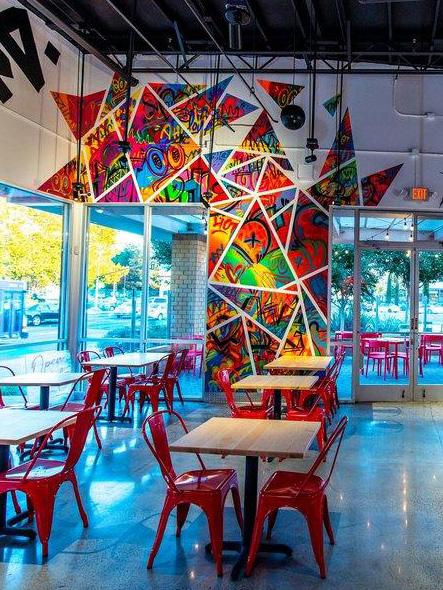
When it came time to order, I decided on a side of mac n’ cheese and an order of “Dave’s #2,” which consisted of a small trayful of fries and two sliders. Since I have a low spice tolerance, I selected the “Mild” spice level. The total bill came out to be $19.49, which is definitely on the expensive side of the fast food industry. The line to order was not as long as I thought it would be and the servers were well-trained and respectful. After a quick seven or so minutes, my order was ready.
I first grabbed a single fry, which was sprinkled with Cajun red spice. Much to my heavy disap-
However, the famous chicken sandwiches lived up to all their glory. Although I expected them to be bigger (the sliders were about the size of my fist), they glistened like how they looked on social media and smelled both buttery and peppery. In between the brioche buns was a layer of melted American cheddar cheese on top of the giant chicken tender, which was topped off with some coleslaw and pickles. I drizzled everything with a few honey packets as per the server’s recommendation.
As I bit into the sandwich, a flavorful explosion of chicken juice and joy combated in my mouth. I could taste the quality of the meat which was complemented by the sweetness of the honey. I found the spice level bearable enough and the coleslaw and the pickles offered some much-needed acidity to each bite as, at times, it could be overwhelmingly rich.
But the one thing that pushed Dave’s Hot Chicken to the top of my fast-food tier list was its ability to keep the chicken crispy. Some restaurants, like Chick fil’ A, fail to prevent their sandwiches from becoming soggy. Others, like Popeyes, sacrifice flavor complexity to maintain a well-rounded texture. Dave’s Hot Chicken was able to find the equilibrium between flavor and crunchiness.
Although it is on the pricier side of the market, I would definitely recommend Dave’s Hot Chicken to those who are displeased with what is readily available. I, for one, will certainly be returning to this planetary experience.

LIFESTYLE THE UNION DECEMBER 2022 10
Courtesy of daveshotchicken.com
Dave’s Hot Chicken opened a location at 1085 E Brokaw Rd. on Nov. 4.
Savan Bollu | THE UNION
By Riya Vyas
Sun, Dec 25
Sun, Jan 1
Mon, Dec 26 No Class
Mon, Jan 2
Tue, Dec 27
Practice Test
9:00am–12:30pm Class 1:30pm–5:30pm
Tue, Jan 3
Practice Test
9:00am–12:30pm Class 1:30pm–5:30pm

Wed, Dec 28
Class 1:30pm–5:30pm
Wed, Jan 4
Class 1:30pm–5:30pm

Thu, Dec 29 Practice Test 9:00am–12:30pm Class 1:30pm–5:30pm
Thu, Jan 5 Practice Test 9:00am–12:30pm Class 1:30pm–5:30pm

Fri, Dec 30 Class 1:30pm–5:30pm
Fri, Jan 6 Class 1:30pm–5:30pm
Sat, Dec 31 No Class
Sat, Jan 7 No Class
ADVERTISEMENT THE UNION DECEMBER 2022 11
No Class
No Class
No Class
Weekly Tes t ing (choose one) Tue – Fr i @ 4:0 0 pm –7:15pm (Pro c tore d) S a t urday @ 9:0 0 am –12:15pm (Pro c tore d) S el f-T ime d Te s t ing (A ny T ime) EXT E NSION SCHEDULE J A N U A R Y 10 – MAR C H 4 Weekly Class (choose one) S a t urday M or ning @ 9:0 0 am –1:0 0 pm S a t urday Af ter no on @ 1:3 0 pm – 5:3 0 pm WINTER BREAK SCHEDULE DECEMBER 27–30 + JANUARY 3–6 Elite Prep Fremont 155 Anza St, Fremont, CA 94539 510.979.0808 Eliteprep.com/fremont Winter SAT Boot Camp December 2022 CONTACT US TODAY TO SCHEDULE A FREE DIAGNOSTIC TEST AND COLLEGE PREP CONSULTATION www.ELITEPREP.com
Magical fall play ‘Puffs’ highlights extra-ordinary lives
By Savan Bollu
Fans of “Harry Potter” have long complained about Hufflepuffs not being represented well enough in the series, but the play “Puffs” by Matt Cox attempts to cast them in a new light. Performed by the MHS Theatre Department from Dec. 1-3, “Puffs” highlights seven years at a wizard school in the life of three Puffs: Wayne Hopkins (Jesus Ochoa), Oliver Rivers (Nitin Ramesh), and Megan Jones (Allie Klaydman).
Each of these Puffs face challenges, including combating the stigma of Puffs being “leftover,” untalented wizards. Their main method of self-defense is the amusing chant, “We are not a threat, please be our friend.”
Meanwhile, Harry Potter is reduced to Dumbledore’s favorite student and an oblivious boy that prances around wearing a tiara during the war against Voldy. Ron and Hermione weren’t even played by real
actors — they were mops. The result is that the play oversimplifies these classic, well-loved characters, but accomplishes its goal of portraying the Puffs as the real heroes.
The play itself starts off with dazzling special effects. The narrator (Shira Corpuz) took to the stage with a flick of their wand, and the lights flickered in response, creating a magical atmosphere. Similar tricks with colored lighting, sound effects, and props brought the magic to life.
The play captivated the audience, which became apparent when the audience gasped and cried, “What?” when beloved supporting character Leanne (Iris Chung) died. The actors effectively balanced out these heart-wrenching moments by keeping the audience laughing during live interaction like jokingly handing out tissues during emotional scenes.
In terms of acting, the supporting characters — especially Cedric (Kenneth Tsau), Hannah (Haleta Ayalew), and Leanne — were humorous and charismatic. However, the main Puffs trio exhibit-
ed somewhat over-dramatic acting. Nevertheless, their over-the-top performance was effective enough to communicate the plot.
Furthermore, because some actors played multiple characters, it was hard to figure out which one they were playing in certain scenes (especially because the costumes were generic), making for a muddled viewing experience. A big drawback was that it was difficult to hear the actors because of unclear enunciation.
The plot of the play also came off as rushed and undeveloped. Wayne, Oliver, and Megan go from strangers to best friends in a few minutes with no clear indication of how. Towards the end, the trio also talks about their journey of accepting themselves as Puffs without showing their process of acceptance. For a play that runs 110 minutes, it needs to do more showing and less telling. Failing to do so made the Puffs come across as superficial children instead of thoughtful individuals.
Overall, “Puffs” was a comedic breath of fresh air from the otherwise dramatic and serious Harry Potter universe.



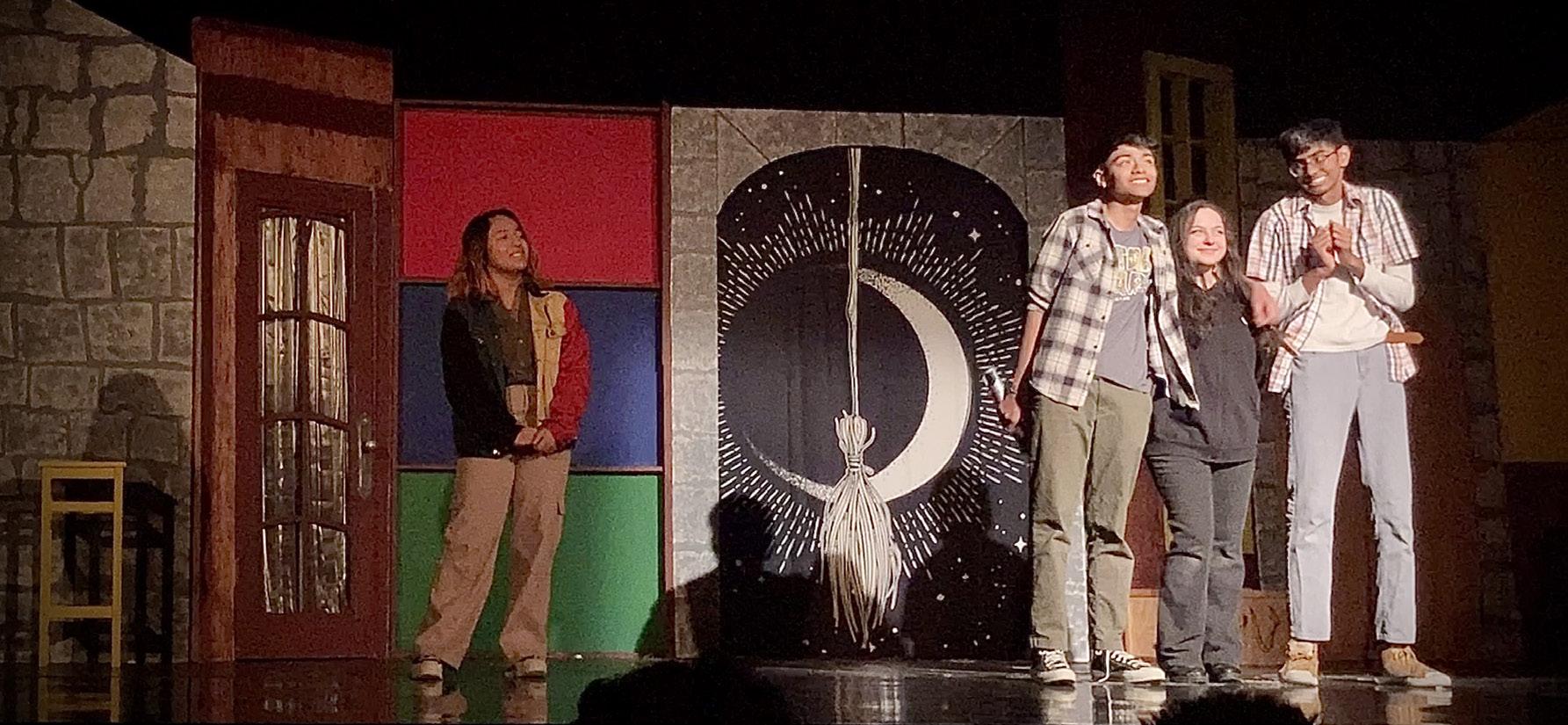







‘All Quiet On The Western Front’ battles with novel, complex issues

 RATING: 3.5 out of 5
By Erick Johnson
RATING: 3.5 out of 5
By Erick Johnson
Many students will recognize the title “All Quiet on the Western Front,” a book by Erich Maria Remarque about the external and internal turmoils soldiers faced during World War One, currently in the sophomore year English curriculum.
“All Quiet on the Western Front” was released on Oct 28 exclusively on Netflix. Directed by Edward Berger, it stars Paul Baumer (a German soldier inspired to join the war with his friends, only to quickly realize that instead of entering a battlefield of glory and fame as he was promised, he has entered a wretched hell of constant misery and pain.
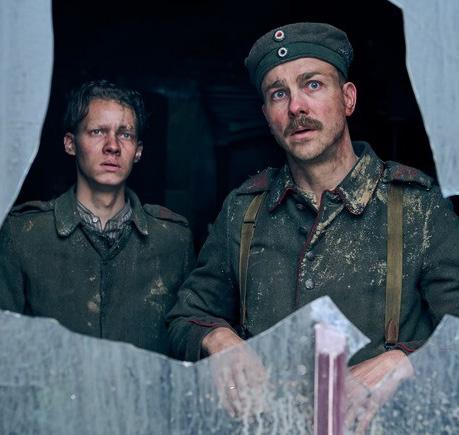
‘Weird: The Al Yankovic Story’ presents
It is weird.
By David Rendon
“Weird: The Al Yankovic Story” is a wild ride from start to finish. Released on Nov. 4 on the Roku Channel, the film parodies a biopic film by telling the wildly exaggerated and almost entirely fictional story of Alfred “Weird Al” Yankovic (Daniel Radcliffe) in true Weird Al fashion. Like the man himself, the film finds joy in following a formulaic template but finding a way to make it entirely its own.
The film plays on the tried and true beats of all biopic films, from the humble origins with disapproving parents — who, in Yankovic’s case, seem to believe that playing the accordion is a sin — to the rise — Yankovic is an overnight success and becomes the biggest star in the world — and fall — a troubled relationship with Madonna (Evan Rachel Wood) who drives a wedge between Yankovic and his band — of the artist’s career and a final soaring return to grace at the end the movie. But the film makes sure to have fun with it, and it lets the viewer know exactly what kind of movie they’re in for at the very beginning. Less than a minute in, we see a bloody Weird Al brought back to life — by Lin-Manuel Miranda in a cheap-looking wig — demanding to be brought pen and paper. This film is wonderfully outlandish and absolutely lives up to its title.
The writing in the film is genuinely brilliant. There are more than a few moments that got a real chuckle from me. Priding itself on its unpredictability and utterly bizarre nature, the film often leaves the audience wondering what just happened and how it did. The second act of the film turns Yankovic into an action hero, the feeling of seeing Radcliffe’s Yankovic, who up until this point has been relatively tame, go on a murder spree in the jungle is nothing short of shocking. Much of the movie also follows Yankovic and Madonna dating, although the real Yankovic said in an interview with Jimmy Fallon, that he has only met her once for about 45 seconds. The film takes comfort in absurdity and asks the viewer to just come along for the ride.
The cast of “Weird: The Al Yankovic Story” does not disappoint, touting big names like Quinta Brunson, Jack Black, Lin-Manuel Miranda, and Rainn Wilson, among others. Despite having so much star power, it does an incredible job balancing the amount of sheer talent on screen by giving each actor a chance to shine. However, Radcliffe, as Yankovic, is without a doubt the star of the film. His absolute commitment to absurdity shows his capabilities as a comedic actor. By deciding to play the character of Weird Al completely straight, by not blinking once at all the ridiculous things happening around him, his acting ele-
odd delight
vates the comedy and bizarreness of the film. Radcliffe’s ability to stay stone-faced as the world tells him that parody writing is a sin is a highlight of the movie.
The film is not without its flaws, however. So much of the film is dedicated to the rise of Yankovic’s career that during the second act of the movie when his downfall starts the movie begins to lose steam. It’s not all that surprising that a movie built around the concept of parody starts to feel a little hollow. It doesn’t help that at this point in the movie a new plot point is introduced that completely takes focus away from the rest of the story. While the movie never outstays its welcome, there are moments, primarily the love story between Yankovic and Madonna, where I could feel myself just waiting for it to start wrapping up. The jokes can start to feel a tad trite, and the film’s charming absurdity starts to lose some of its charm. However, it recovers relatively quickly and begins to conclude the film cleanly and effectively in the third act as Yankovic returns to the good graces of fame.
The movie is an absurdist paradise, a love letter to parody, and a home for oddity. While it likely won’t go on to win any awards, except for its soundtrack — which the film itself pokes fun at with a real lyric in the end credit song being “This song is technically eligible for Oscar consideration” — it is guaranteed to deliver some laughs and an overall good time.
The movie immediately makes something abundantly clear: it is a gore fest. The action scenes are intense because they do not focus on the action itself; instead, the main focus is how the ongoing battles are affecting Paul’s sanity. During these moments, the camera constantly keeps cutting back to Paul’s reaction to the ongoing massacre, and as the movie progresses and the violence gets worse, Paul seems to distance himself from his surroundings. The movie greatly captures how the senseless death slowly destroys Paul’s humanity; every time Paul witnesses the bloodshed around him, he dissociates from it more and more, reacting more indifferently to the chaos, something that was well translated from the novel. It helps the audience understand what Paul is going through, and it humanizes his character. Not only does the viewer see what Paul sees, but they feel what he feels, adding depth to his character.
The acting is phenomenal, and Kammerer shows he is capable of portraying true horror through his emotional moments. The score is well implemented, adding an eerie feeling to the movie. However, where the movie truly shines is its cinematography. Every frame is a masterpiece, from start to finish. The movie has a beautiful color palette that illuminates the screen.
The composition of the battle scenes is surprisingly immersive, it appears the director
wanted the viewer to feel like a soldier watching the events unfold. The composition of the shots along with the colors is the best asset this movie has. The visuals alone make this movie a worthwhile watch. If you enjoyed the novel, you will be surprised that the film experience is so different. It feels like you are watching a completely different story that simply borrowed some elements from Remarque’s book. The movie strays so far away from the book that it might as well be considered an entirely different script. In the novel, Paul and his friends join the army at the start of the war, and as the war progresses, he slowly loses his friends and himself in the conflict. In this new movie adaptation, Paul joins the war in 1917 (a year before it ends). This change shifts the focus from how war destroys the human soul, to the futility of war, represented by the millions that are still dying while the war is already beginning to end.
Only the character names were left unchanged and most characters’ importance is reduced, while some are excluded from the film entirely. Notable characters like Himmelstoss, the authoritative general who torments Paul during training, have been removed and instead replaced with General Friedrichs. Both characters fit the role of an authoritative figure who seeks only glory for Germany instead of looking for the nation’s citizens. This change, like many others in the film, feels like they were implemented to adjust to the two-hour run time of the movie. The movie still drives home the same messages of anti-authority and the raw cruelness of war and includes the most important segments from the novel, otherwise, everything is different. These differences do not make the movie bad, they simply retell the story in a different way.
In essence, “All Quiet on the Western Front” has many great elements like cinematography and acting which merit a recommendation, and fans of the book shouldn’t be discouraged from watching it by expecting an exact recreation of the book. The movie has a lot of emotional, intense, and heart-wrenching moments that will make every second worth it.
ENTERTAINMENT THE UNION 12 DECEMBER 2022
RATING: 4 out of 5
Felix Kammerer (left) and Albrecht Schuch (right) act in the adaptation. Courtesy of cineeuropa.org
MOVIE REVIEW
MOVIE REVIEW
Shira Riz Corpuz, Jesus Ochoa, Allie Klaydman, Nitin Ramesh (left to right) in “Puffs” at the MHS theater.
PLAY
® RATING: 3.5 out of 5
Savan Bollu | THE UNION
REVIEW
‘Falling for Christmas’ falls short of expectations























 By Deeksha Venkateswaran
By Deeksha Venkateswaran
“Falling for Christmas,” released Nov. 10, 2022, directed by Janeen Damian, follows a cliche, humorless plot, leaving the movie dissatisfying for viewers and far off from the “romantic comedy” it was marketed as. As Lindsay Lohan’s first starring role in around ten years, I anticipated a strong comeback, yet the film was utterly disappointing. The film’s lazy direction and the absolute lack of romantic chemistry between the two leads was made worse by a predictable plot.
The movie follows a woman named Sierra (Lindsay Lohan), characterized as a spoiled daughter living in luxury with her father’s money. Her boyfriend, a social media influencer, proposes to her on a cliff, but before she could say “yes,” she slips off the edge and loses
her memory in the process. She is then found by Jake (Chord Overstreet), who allows her to stay at his lodge with his mother-in-law and daughter where they help her regain her memories. Throughout the course of her stay at the lodge, she starts to fall in love with Jake while learning how to fend for herself and be independent, something she never did prior to losing her memory.
The overly corny jokes in the movie made the movie cringe-worthy. For example, after losing her memories, Sierra attempts to make breakfast, but because of her inexperience, she ends up spilling the food everywhere.
traditionally feminine roles such as cooking and cleaning, even going as far as taking on a motherly role for Jake’s daughter. Her independence conveniently didn’t involve anything which traditionally “masculine.”
REVIEW
The comedic music track in the background implies that the scene is meant to be funny but it simply is not. The jokes were poorly scripted and the acting was forced. Sierra’s character also played into stereotypes under the guise of independence as she began taking on

The romantic chemistry between Jake and Sierra was very forced, making it hard to watch. Lohan and Overstreet seemed to have no connection, most of the time looking as if they were creating a video for a school project. I felt no connection to the relationship between characters nor did I feel any empathy towards their situations due to the terrible acting.
I would definitely not recommend this movie unless you want to be able to predict everything without even watching the first half. The poor directing and writing of this movie are truly disappointing and I wish I could take back the two hours I spent watching it.
RATING KEY
All I want for Christmas is You
Last Christmas Feliz Navidad Let it snow Baby, it’s cold outside
Gothic charm spooks in ‘Wednesday’

RATING: 4 out of 5
By Sanvi Parvatikar
Tim Burton’s “Wednesday” greets viewers with a bloody start, as Wednesday (Jenna Ortega) takes gory revenge upon her brother’s bullies by unleashing piranhas into the pool. As she enters Nevermore Academy, following her expulsion from her old school, viewers experience a world of eccentricities while Wednseday explores murder, mystery and her own history.
As a viewer, it is important to notice how the Black characters in the show are antagonists whose redemptions come quite late in the show. Bianca (Joy Sunday) is portrayed as a treacherous siren, and while she wasn’t the final villain, she still proved to be a thorn on Wednesday’s side. Burton was ignorant in choosing the Black Mayor (Tommie Earl Jenkins) to own Pilgrim World, especially since the theme park is dedicated towards racist colonizers.
This isn’t the first time Burton has been called out for his treatment of POC characters.
Black Panther makes powerful return in sequel
RATING: 4.5 out of 5
By Varun Ravuri
Marvel’s “Black Panther: Wakanda Forever,” released on Nov. 11, 2022 as a sequel to the original “Black Panther,” continues the series by showcasing other characters after Chadwick Boseman’s death.
The beloved, original “Black Panther” released in 2018 introduced Wakanda, a city rich in a metal known as vibranium that fueled their immense and advanced technology, making the most powerful country in the world.
It featured Black Panther (Chadwick Boseman) as the king of Wakanda. Following Boseman’s death, the series had to adapt with the original Black Panther’s sister, Shuri (Letitia Wright), playing the lead role in “Wakanda Forever.”
“Wakanda Forever” follows Shuri and her mother (Angela Bassett) who must navigate a life without the Black Panther and face new enemies that of equal or greater strength.
Despite missing Boseman, who fans admired during his time in the series, the film did not lack in terms of directing, plot, or humorous aspects. New, innovative ideas were introduced in terms of Wakan-
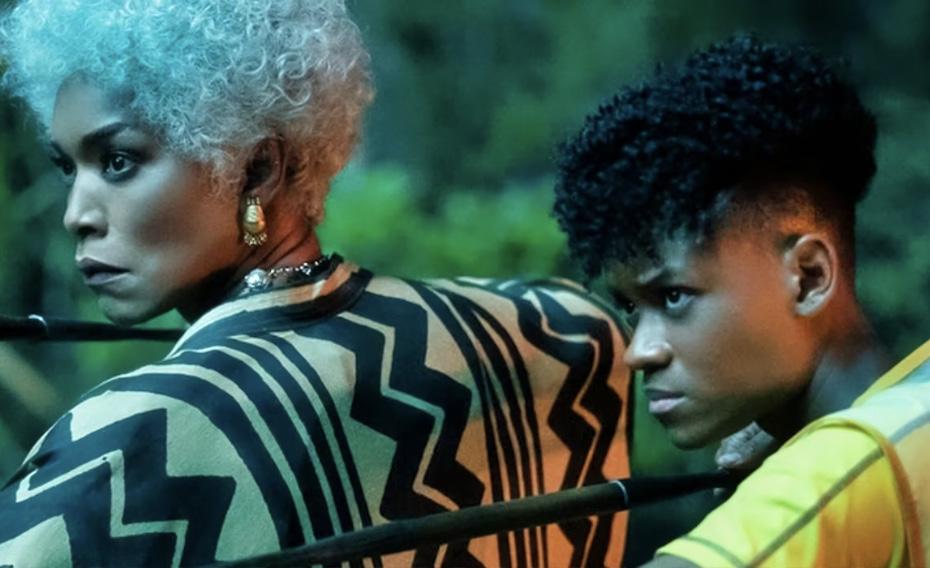
dan technology while interactions with the outside world revealed Wakanda’s true potential.
In terms of humor, the film maintains the perfect balance between occasional jokes and serious action scenes. Throughout the film, the audience remains lighthearted because, until the film approaches the end where it begins to tense up, action scenes are always complemented with dialogues of some sort that make the viewer laugh. This adds to the film’s overall appeal and kept me hooked in throughout the course of the experience.
When it comes to the directing aspect, the Marvel Cinematic Universe (MCU) did an amazing job at incorporating elements such as graphically-enhanced underwater scenes and new technology that contributed to the plot. I felt that I was almost in the movie myself with the help of scenes that were so well-directed and visually appealing, such as underwater kingdoms or battle scenes.
Shuri definitely played her part and carried on Boseman’s legacy, however her acting and character was not up to par with him. Her role in the film often hesitates to do what is necessary for the Wakandan Kingdom; it gives the feel of
a growing teenage girl rather than the lead role in an MCU movie. Being the most important character, I would have found the film even more meaningful if it were led by someone more responsible and capable while allowing Shuri to continue her role as Wakanda’s scientist.
Since the first “Black Panther,” it has been ingrained in viewers’ minds that Wakanda is the most powerful country ever to exist in the MCU. However, by the middle of the film, I began to doubt whether that still holds true as Wakandan society faced off with their enemies and even faced brutal destruction at one point. Nevertheless, by the end of the film, it is once again confirmed that Wakanda is a force with undeniable power as it emerged victorious.
These shifts between destruction and victory that the plot creates add appeal to the film and keep it interesting despite being a lengthy 2 hours and 41 minutes. The movie’s omnipresent sense of power left me with respect for the movie and made it a worthwhile experience.
In short, “Black Panther: Wakanda Forever” is a mustwatch film that perfectly combines humor, action, and a noteworthy plot, presenting itself as a worthy sequel to the original Black Panther.
In Burton’s “Miss Peregrine’s Home for Peculiar Children,” Samuel L. Jackson, a starring actor, remarked the movie might’ve been the first time Burton casted a black character in his movies. The main cast in Wednesday are lighter skinned, and Burton’s hesitance to cast darker skinned characters, let alone in a positive light, is a disservice to
viewers of the 21st century.
Nevermore Academy is also hypocritical to witness because despite being marketed as a school for outcasts, there is a great sense of conformism. Wednesday sticks out in the school of outcasts and is one of the few cynical people there. The students fear her murder allegations, despite being home to blood-sucking vampires and werewolves. Wednesday’s status as an outcast doesn’t reflect the values Nevermore pledges for, and is a poor attempt at creating conflict.
I enjoyed the interactions between Wednesday and Enid (Emma Meyers), her roommate at Nevermore. In a stark contrast to Wednesday’s gothic skepticism, Enid is a bubbly character with a penchant for gossiping. Their room is a clear reflection of their differences, with Wednesday’s side obviously being more gothic in nature.
The show also explores Wednesday’s psychic powers, and her ability to see events that had occurred in the past. Wednesday’s resilience towards figuring out the murders was quite admirable, and I loved how she utilized her powers rather than solely depending on them. The scene where Wednesday figured out a riddle regarding the Nightshades, a secret society within the school, was a stark example of her intelligence, and well represented her deduction skills.
Overall, Wednesday is worth the watch, and I would highly recommend it to anyone looking for a fun and spooky watch.
ENTERTAINMENT THE UNION DECEMBER 2022 13
RATING: 0.5 out of 5
Angela Bassett (left) and Letitia Wright (right) play Queen Ramonda and Shuri, respectively, in the movie. Courtesy of The New York Times
MOVIE REVIEW
TV REVIEW
Zaynah Turabi | THE UNION
MOVIE
Sweet or sorrowful? Fall athletes reflect on bittersweet senior nights
By Riya Vyas
Senior nights are a time-honored tradition, allowing coaches and athletes to show appreciation for senior players as they celebrate the end of their high school athletic careers. The celebrations are often joyous and sentimental, as seniors receive gifts and say goodbye to teams they’ve often been a part of for several years.
“It’s the burden of our underclassmen to do it,” captain of the varsity girls tennis team Emily Jang said in a Zoom interview.
“It’s a tradition that we’ve passed down through the years.”
Girls’ tennis senior night took place on Oct. 18 against Santa Clara High School—a week earlier than the traditional senior night which would take place during the last home game, Jang said.
The juniors are “tasked to, as sneakily as possible, find out the favorite snacks of all the seniors,” Jang said. “This year they got me this giant stuffed pig and more snacks than I can ask for.”
Student athletes learn many techniques through older, more experienced players, in addition to their coach, Jang explained.
Senior nights serve as a way of thanking those students for passing down that knowledge and being great role models, she added.
Girls’ volleyball senior night took place on Oct. 26 against
Homestead High School, senior Libero Serene Joseph said in a Zoom interview. It was organized by volleyball head coach Marissa Canez, juniors on the varsity team, the junior varsity (JV) team, and the freshmen team, she said.
“Usually, we as a team come in when we have a home game, … and help set up the nets and the stands,” Joseph said. “But this time, we, the seniors, were banned from coming into the gym until 5:30.”
The girls’ volleyball team invited family, friends, and teachers; their match was packed with people, posters, and balloons, Joseph said.
“This year, we had fairy wings given to us, as well as these laurels on our head, and a shirt that specifically had our class color,” Joseph said.
Joseph felt that her senior night was bittersweet because she’s been playing for a long time and was sad to see it end, she said.
“At one point, you’re like, ‘Oh, there’s always next year,’” Joseph said. “You always try out in the same process again. But this year is like, ‘Oh, like this is it? This is the last thing that’s going to happen.’”
On the bright side, the volleyball season didn’t end on their senior night because they won their match against Homestead and qualified for the Central Coast
Section (CCS), Joseph added.
“The main thing I was reflecting on was how long I’ve been playing, the experience of it, and how I’ve grown from point A to what I’ve become right now,” Joseph said.
Senior runner Ethan Bautista had a slightly different experience during varsity boys cross country senior night, which was organized by the varsity girls’ cross country team, he said in a Zoom interview.
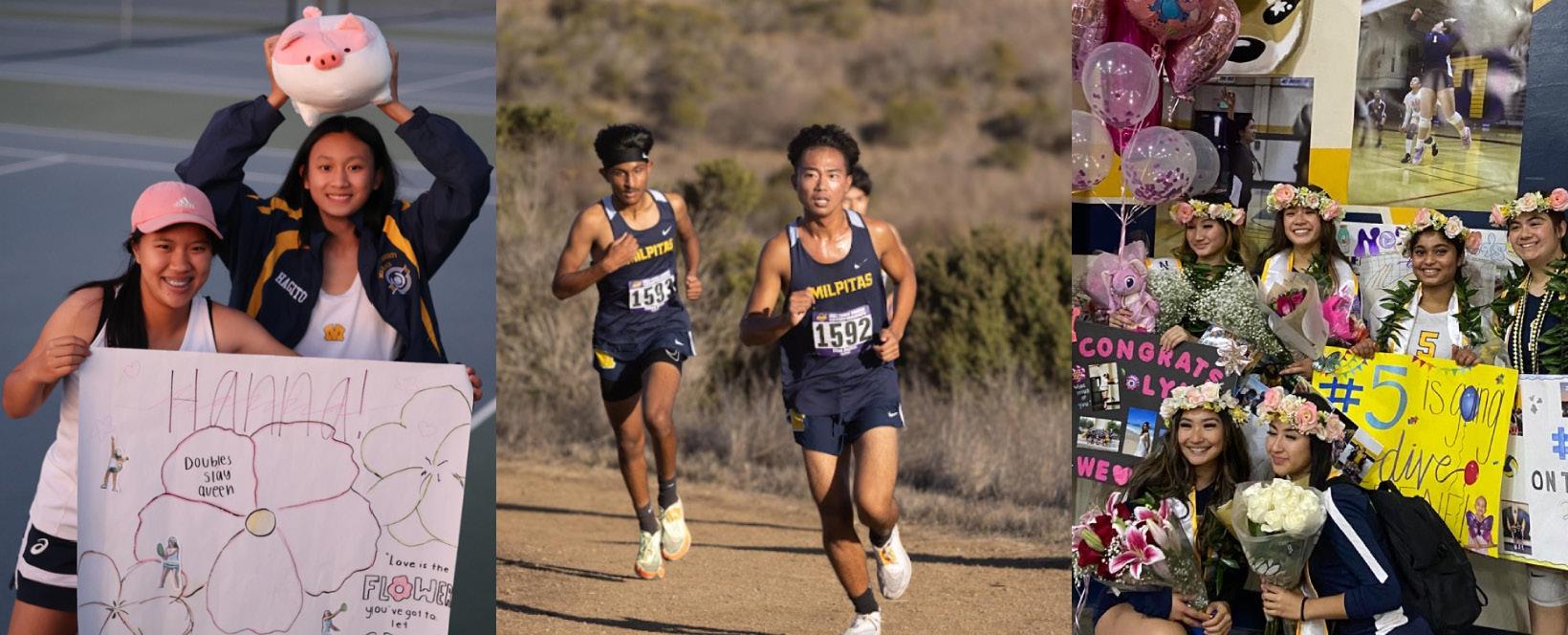
“It wasn’t in a school; it was in a park setting,” Bautista explained. “To me, it was just the same thing.”
The varsity girls’ team made posters and brought food for all the senior cross country boys, Bautista said.
“We were just striving to win this meet (senior night) because we haven’t won all the championships since 2002. Winning it this year is a big accomplishment, not just for us, but also for the whole school,” Bautista explained. “The cross country team at MHS is one of the underdog sports compared to basketball and football.”
As a parting comment, Bautista said to “just have fun on your senior night.”
“Last year, senior night was a really touching thing,” Jang said. “I gave a speech, and it felt like a full circle moment where the team can show appreciation to all the seniors for everything they’ve done. It just felt like a really big thank you.”
Boys varsity basketball team shoots for playoffs
By Deeksha Venkateswaran
Boys varsity basketball officially began its season at MHS with a 51-36 victory on Nov. 30 in a non-conference game against Woodside High School, according to the MaxPreps website. This year’s team five to six players who can score exceptionally well and have the potential to have big games, coach Champ Wrencher said.
“My goal is very short-term, just to be in good physical condition and practice right on the nose to be prepared for each game,” Wrencher said.
Focusing on executing the fundamentals correctly every day will in turn allow bigger goals to fall in place, he said.
“Conditioning, and figuring out how to execute the game plan — those are things that we can accomplish every day, especially when you have the right people,” Wrencher said. “This group practices incredibly hard, and I almost have to save them from themselves.”
Being careful about what activities are done during the practice and the length for which they are done is important to deal with this, Wrencher added.
“My method is to figure out what type of talent there is, and if there are a lot of fast players, is to implement something that takes advantage of that,” Wrencher said. “Some years, we have a lot of tall players. So you have to institute a plan to take advantage of your height. And so it varies from year to year, depending on the talent.”
This year, the team has a variety of talents amongst its players, so figuring out the right mix is important before every game, Wrencher said.
The group plays quite well considering they are new, senior team captain and point guard Jacob Oldham said.
“I don’t really care about how many points I score, like my personal stats, but I just want to win and lead this team to win,” Oldham said.
There is still much room for improvement, but the team is currently on an upward trend, Oldam said.
“I think the group has a lot of potential,” senior team captain and shooting guard Landon Nguyen said.“We’re very young and play sort of excited and aggressive. We do have to be more polished.”
The group itself has not played together very much until this season, so building team chemistry to be more cohesive is important, Nguyen said.
Some of the team’s goals are winning leagues and playing to the best of their ability at playoffs, Oldham said.
“There’s some things that this team can make happen,” Wrencher said. “And they don’t need an offense. They don’t need a play. They can just kind of make things happen on their own with their natural athletic ability.”
“This is the most dedicated group that I’ve had,” Wrencher said. “We have a good collection of people who are used to winning, and it’s going to be exciting to see how it plays out.”
By Kevin Ting
The varsity boys cross country won the Central Coast Sectionals (CCS) championship on Nov. 12, qualifying for the state championship cross Country coach Yohaness Estifanos said.
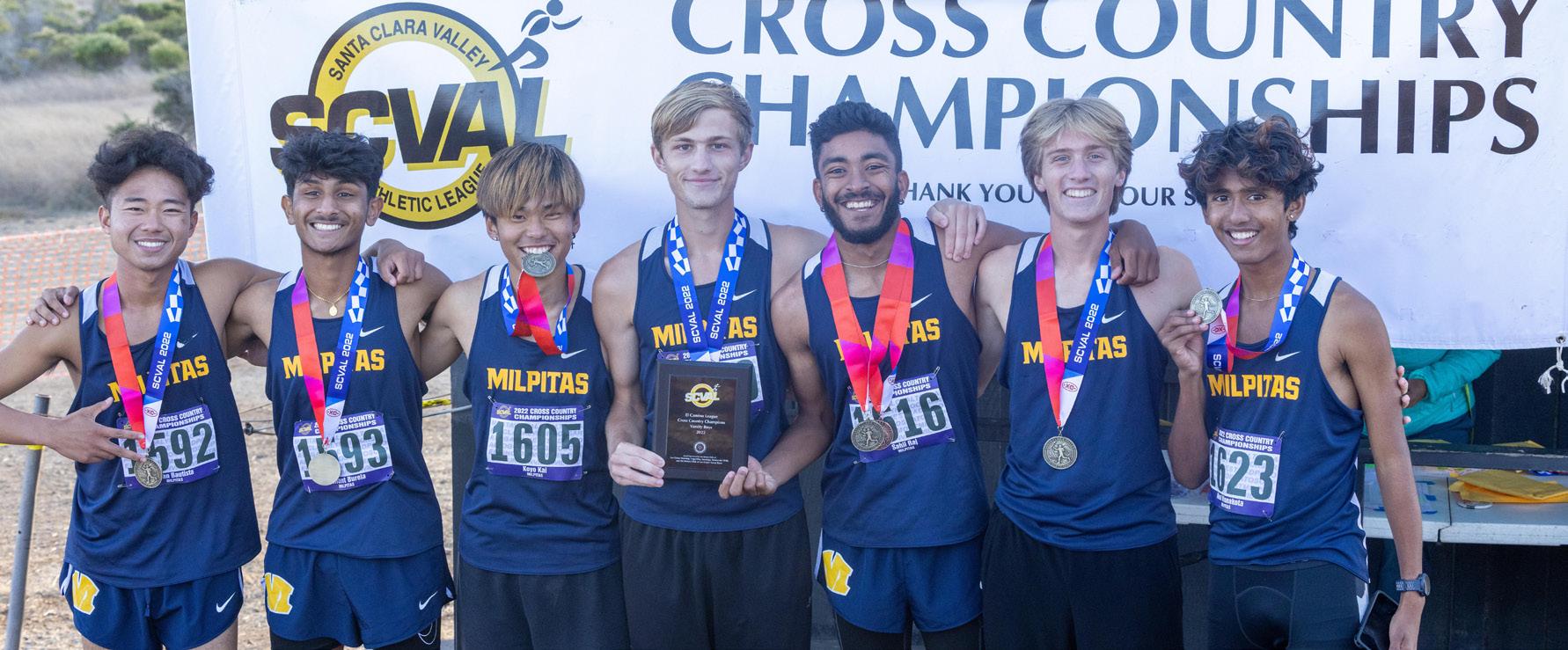
The team was one of only two teams in the league that qualified for the state championships as a team, Estifanos said. This was the first time they qualified as a team for CCS in the team’s history, Estifanos added.
“The varsity boys had a historical five-team wins this season, including the Santa Clara Valley

Athletic League (SCVAL) league and CCS finals,” Estifanos said.
The championship took place at Crystal Springs and competitors needed to run the hilly, 2.95 mile course in order to qualify for the state championship, senior Alex Althouse said.
The team’s major rival in the race was Bellarmine College Preparatory, the fastest team in CCS prior to this year, Althouse said.
“We lined up on the line, and I remember that Bellarmine was right next to us,” Althouse said.
“Their coach came up to them and said, ‘On your left is your competition,’ and he was pointing at us.”
The team did not actually perform their best at the CCS championships but took the title anyways, Althouse said.
“We were actually tied with them at the two-mile mark,” Althouse said. “But we ended up making up that ground with a lot of our guys passing their guys, allowing us to take the win by two points.”
Winning by two points is extremely close in cross country, senior Koyo Kai said. Since the point system is based on placements, winning by two points meant that the team’s victory was only off by a placement or two, Kai said.
One of their victories included
the Farmer’s Invitational meet, hosted at Hayward High School, which was the team’s first win of the season, Althouse said.
“That was when the whole team realized that the effort we put in was showing,” Kai said. “Before that, we were just working, so we still weren’t sure if we were going to win anything from that.”
Going into the season, Althouse was confident about that the team had the ability to qualify for states, he said.
“On the ranking for the twomile long races, we were second and we weren’t far behind from Bellarmine,” Althouse said. “That’s when we thought it was going to be possible.”
In order to prepare for the season, each individual on the team went through rigorous training throughout the entire summer, according to Kai. The summer practice was not organized by the coach, but by the individual members of the team.
“Going to states was a dream since our freshman year, so I think we all knew what we had to do to win CCS,” Kai said.
There were a lot of other changes made to the team’s practices during the normal season too, such as the frequency and intensity of practice Kai said.
“The amount we run has increased. It’s 60 miles a week constantly,” Kai said. “I think how we look at practices has also changed— we’re a lot more focused.”
Despite the amount of work they put in individually, a lot of the team’s success was due to Estifanos, Althouse said.
“He can keep up with us in all the workouts, and it’s really helpful to have someone be able to do that,” Althouse said. “I think he is the biggest reason we are as fast as we are now.”
The team’s success this season means a lot to Estifanos, who is now receiving his third CCS title, including his two prior wins as a student-athlete and now one as the coach of the team he was once a part of, he said.
“The varsity boys have paved the way, showing how far we can go as a team with hard work and dedication,” Estifanos said.
SPORTS THE UNION DECEMBER 2022 14
divisional
Racing towards the finish: Cross Country achieves victory at
championships
Boys varsity cross country celebrates qualifying for the Central Coast Section Championships at Belmont.
Courtesy of Ethan Bautista
Tennis players Serena and Hanna Lam (left) pose with posters and gifts. The varsity volleyball team (right) poses with flowers. Cross country runners Sidhant Burela and Ethan Bautista (middle) run to the finish.
COURTESY OF EMILY JANG, ETHAN BAUTISTA, AND SERENE JOSEPH
Tiffany Lieu | THE UNION

ADVERTISEMENT THE UNION DECEMBER 2022 15
Kononenko family supports Russian-Ukraine war refugees, aids war efforts Annual food drive returns
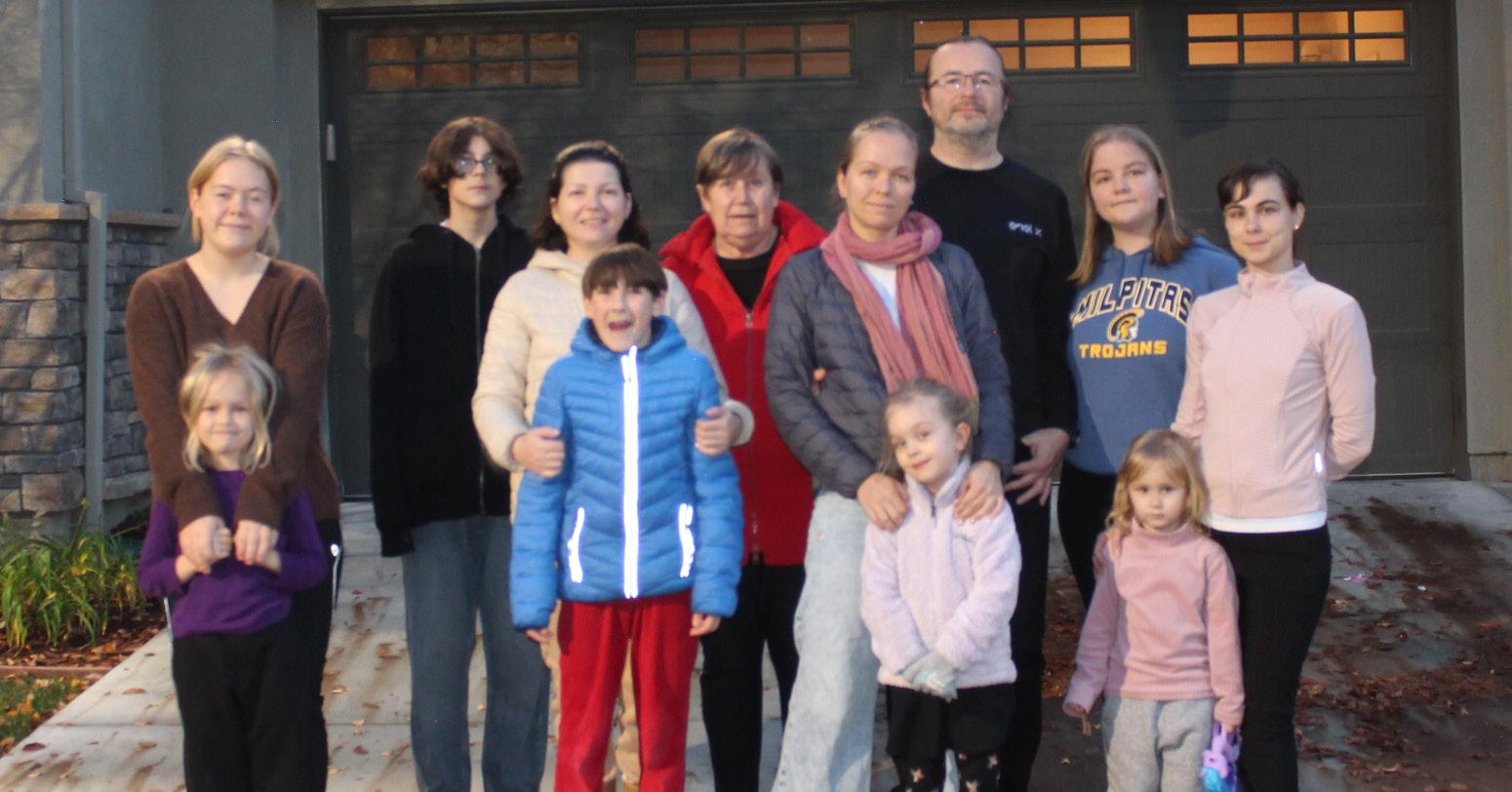
FROM PAGE 1
committee lead Davin Jeng said.
“For the most part, the drive is pretty similar to last year, including collections, donations, and incentives,” Jeng said. “We have, however, brought some old events, such as Coins for Change.
It’s a mini-class competition in which each class collects and donates coins, where coins count for positive points, and dollar bills count for negative,” Jeng said.
Despite collecting fewer donations, ASB is attempting to refrain from adopting the drive’s traditional competitive nature, Heraldo said. In the past, MHS has also tried to challenge other local high schools, but this year, the emphasis is being placed on just bringing MUSD together, Heraldo said. The theme of this year is ‘Comm-UNITY’ as the district plans to bring together its various schools to give back to the city, he said. The change came in subtle ways, such as changing ‘Penny Wars’ to ‘Coins for Change’ and ‘Duct-Tape Wars’ to ‘Floor is Lava’ and encouraging students to work together amidst friendly competition, Heraldo added.
“MHS plays a huge role in the Jack Emery Drive,” Heraldo said.
“Last year, we raised a third of the total amount of 133,000 cans. A lot of donations come from our school, and I think it’s important that we come together and support those in need with this drive,” he added.
Special education substitute wage rate increases
FROM PAGE 1
it may not be worth it to a few teachers,” day-to-day substitute Jenifer Lind said.
Special education classrooms are where the most crucial need for substitutes is, Jordan said in an interview. The district wants to attract more people to fill the vacancies there, so they approved the wage raise to be effective from Nov. 16, 2022, through July 31, 2023, she said. The Board’s decision to make the policy interim is mainly due to the current outbreak of viruses, she said.
“We do not foresee that COVID, compounded by the flu and the respiratory syncytial virus (RSV), will be an ongoing reason for current substitute teacher absences,” Jordan said.
As of Dec. 5, there are currently 174 active certificated substitutes, according to the MUSD Director of Human Relations, Damon James. However, the issue is not necessarily about the number of substitute teachers on duty, he said.
“Substitute teachers are contractors, so they choose which positions to accept,” James said. “There are times that we have jobs and substitute teachers available, but ultimately, the type of classroom, lesson plan provided, school location, and subject matter plays a role in their decision.”
The estimated increase in cost to the district’s general fund from the new wage policy is $25,000, Jordan said. The district decided on the $50.00 increment amount with an understanding that MUSD is well-funded relative to other school districts, she added.
“We took into consideration of comparable school districts, such as Palo Alto Unified, Fremont Union High School District, and Santa Clara Unified, that can pay
FROM PAGE 1
and grandma have lived with her family in Milpitas for six months now, she said. Her uncle is required to stay back in Ukraine to serve in the military if he is called into active duty, a harrowing situation the Kononenko family is too familiar with, Alena Kononenko said.
When Kononenko’s other uncle was recently drafted, the family sent a package filled with helmets, jackets, bulletproof vests, guns, and ammunition they bought in California, Alena Kononenko said. Both the Russian and Ukrainian forces are losing men, supplies, and training as the win-
ter rages on, she added.
“These are shop clerks, teachers — just anybody who is in that age group (18-60) gets thrown out there without training, like pawns in some stupid game,” Alena Kononenko said. “You have to really hope that they don’t just die.”
To cope with the situation, the Kononenko family has contributed as much as possible to the war effort, she said. Driving a minivan full of war supplies from London to Ukraine and straight through enemy territory, Kononenko’s father directly supported the Ukrainian army in the most surreal way imaginable, Alena Kononenko said.
After immigrating to New York, Uliana Kononeko remembers living out of a closet fashioned from Amazon boxes and zip ties, wanting more than anything to return to Russia, she said.
“Now I know that was the best decision we could make,” Uliana Kononenko said. “I think I was so adamant to go back because in Russia, all I heard at school and on TV was how amazing the country was,” she said.
Pledging allegiance to a picture of Putin every morning and having history lessons on global events like World War II that indoctrinated a deep-seated hatred for Germans and Americans were just parts of daily life at school
in Russia that contributed to immense brainwashing, Alena Kononenko said.
“I was proud of being Russian and told everyone that I moved here, I overcame things, and I can speak a different language,” Uliana Kononenko said. “Then, in the sixth grade, I was bullied about being a ‘Russian spy,’ and that woke me up to the public view of Russians.”
Uliana Kononenko said that the current conflict has led to quite uncomfortable discussions, most in the form of well-meaning support.
“I was talking to one of my teachers and told her I’m Russian-Ukrainian. She asked me, ‘How’s the whole war going?’” Uliana Kononenko said. “It’s not really a casual conversation topic, but with the news and everything, people just don’t make the connection that it’s real people behind the damage you see on TV.”
Alena Kononenko’s counselor called her in one day, informing her that other students were spreading rumors that she supported Russia’s invasion, she said.
“I felt so betrayed because half of my family could have been dead on the ground,” Alena Kononenko said. “How dare you think I would support that?”
Russians and Ukrainians are not the only ones affected by the war, Alena Kononenko said. Putin is fearsome because he has nothing to lose, she said.
“Pay attention — even if it’s not hurting you now, it will soon,” Alena Kononenko said.
higher wages to faculty members due to community-based funding,” Jordan said.
The efforts required to manage the behaviors of special education students are more straining in comparison to those of standard education students, Lind said.
“No matter what level of special education you are teaching, you will have to be on point all class period, shutting down any misbehaviors, keeping the students focused on the assignment,” Lind said. “So you could either do that or you can sit behind a desk, tell students to check Google Classroom, and read a magazine. That’s why no one is picking up special education openings.”
Although the wage raise has been implemented, there are still not enough substitutes that sign up for special education classes, according to staff secretary Joyce Pahimulin, who oversees the substitutes at MHS.
“HR has to hire more substitutes,” Pahimulin said. “Usually, our subs are pre-arranged with teachers, so that when a special ed teacher calls in, there are no more available subs because they are already committed to another class. In that case, we have to request teachers to cover the unfilled sub-jobs.”
Pahimulin said she appreciates the Board’s efforts in encouraging substitutes to accept jobs in special education classrooms, but she believes it is too early to tell if it will be enough to end the shortage.
“There should be training for substitutes that’ll prepare them to work with students with special needs because if you are not familiar with them, you would be scared to take on the responsibility,” Pahimulin said. “The raise should’ve been permanently implemented since the cost of living is not stagnant. … Otherwise, what will happen next year?”
Jordan also mentioned that the district is developing a program to incentivize current employees to refer candidates and paraeducators to become substitutes.
Gary returns, seeks improvements as interim principal
FROM PAGE 1
people exit the campus before lunch,” Gary said. “These are people who don’t have a classroom and who are not dealing with students at the time.”
During school, restroom and pass policies should be preventative, Gary said. Making passes meaningful by having administration and security check on students outside during class is the first step, he said.
“I’ve been out there in the campus every day, and I have a hard time spotting any security, despite the fact we have eight on campus.” Gary said. “If the security were visible and in uniform, it’s a preventative measure and reduces the need to apprehend students.”
Observation is the most powerful tool to see what truly happens on campus, Gary said. One of the first issues he heard about was cutting in the lunch lines, so his solution was to set an example of active lunch duty, he said.
“One of my sayings, or ‘Chuckyisms,’ is to inspect what you expect,” Gary said. “So when I got back to MHS, I made sure to go to places where students were. That’s why you can find me at the cafeteria lunch lines every day, inspecting for cutting and introducing myself to the students.”
After listening to a presentation on state test scores at the board meeting on Oct. 11, Gary felt he could address the persistent racial achievement gaps in state test scores, he said.
“Over 20 years ago, with the help of African American and Latino teachers and alumni, I started doing assemblies with African American and Latino students called Flamekeepers and Horizontes to address the prevalent achievement gap,” Gary said.
Horizontes and Flamekeepers were programs ahead of their time, Spanish teacher Kimberly Marion said.
Gary possesses all the qualities of a great leader, English teacher Heidi Shannahan said. Gary represents an era of stability that MHS needs, she added.
“After four principals, unfortunately, there isn’t much carryover on the day-to-day aspects of the job.” Shannahan said. “We’ve really needed that continuity, and we never had that.”
Marion’s initial job interview with Gary took her by surprise as she had taught around the world but had never seen an African American principal, she said.
“The way he carries himself, it’s clear that this is his calling,” Marion said. “You can tell from one conversation that he is a lifelong learner.”
Gary grew up in Richmond, California and moved to the Milpitas Sunnyhills neighborhood, one of the first racially integrated neighborhoods at the time, for
high school, Gary said. Milpitas gave him an opportunity to learn without restrictions, he said.
“When I came to Milpitas from Richmond, I was one of those kids in the school system that the counselor said I wasn’t college material, and I needed to do something with my hands,” Gary said. “At that time in history, the pathways were very prejudicial. It wasn’t about what you could do; it was about your skin color.”
Gary wanted to provide others the opportunity that Milpitas gave him, he said. He wanted to become an administrator because he wanted the people in Sunnyhills to know what they were capable of, he added.
“I have an opportunity at MHS that a lot of people don’t, which is to see their impact 20 years down the line,” Gary said. “The experiences I have had in the past have led me to this moment.”
News Brief
The Pledge of Allegiance will no longer be a part of morning intercom announcements during second period, according to an email Associate Principal Skyler Draeger sent to staff on Thursday, Dec. 8. However, the U.S. flag will still be raised while the national anthem plays before school. The change was decided at a School Leadership Team meeting on Dec. 7.
NEWS THE UNION DECEMBER 2022 16
The Kononenko family gathers after some were forced to flee Ukraine admist the Russia-Ukraine war. Courtesy of Alena Kononenko

















 By Albert Fung
By Albert Fung









 By Tiffany Lieu
By Tiffany Lieu















 By Albert Fung
By Albert Fung

































